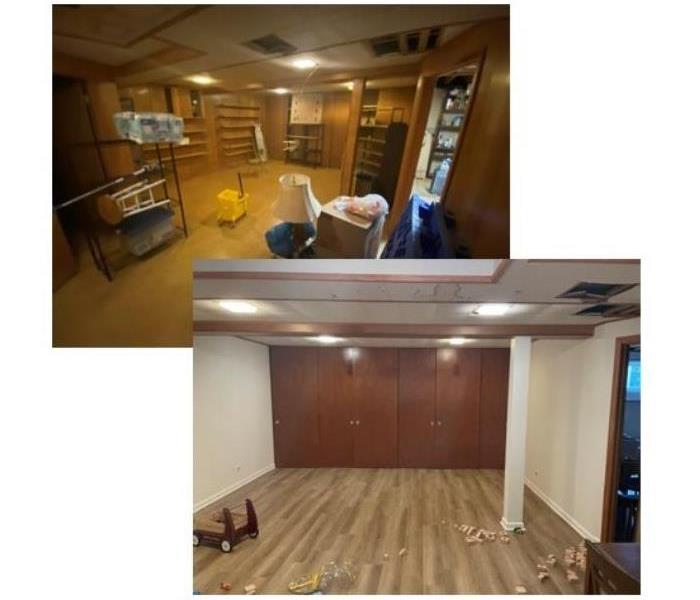Archived Water Damage Blog Posts
From Disaster to Restored!
10/27/2023 (Permalink)
From the first call to the last walk through- out our SERVPRO goal is to make water damage claims “Like It Never Even Happened.” When our office receives a call about a utility sink that has flooded a basement, we know to send our highly trained and accredited staff to accurately capture the loss and inform the insured every step of the way.
Immediately once onsite, the SERVPRO crew will begin to map out the water migration and discuss what has been affected, and how we plan to mitigation the affected materials. In this case, the standing water saturated the tile flooring and the paneling on the walls. Our team moved swiftly and effectively to move contents, remove affected materials that could not be dried, and placed adequate air movers and dehumidifiers to reach the drying goal of each material.
Once we have confirmed the water damage portion of the claim is completed, our reconstruction manager will be onsite to conduct his walkthrough and discuss how the insured envisioned this space to look after such a traumatic loss. The insured shared their vision with the team, and soon after that visit the scope was put together, insurance was informed of the process, and contractors were on site for their evaluations.
From start to finish, our team takes pride in constant communication, quality work, and standing behind any final product that we have a hand in creating. For a one stop shop, from mitigation to reconstruction, general cleanings, mold remediation, commercial cleaning services and anything in between- call the leaders in the restoration field! SERVPRO is always here to help- give us a call today! (630) 377-7062
4 Easy Steps To Flush a Water Heater
7/25/2022 (Permalink)
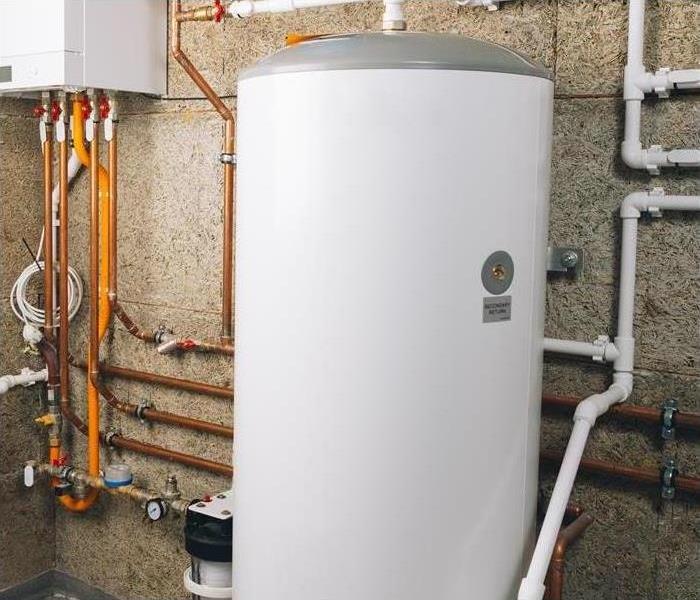 Conduct a water heater flush annually to ensure your water heater is working efficiently.
Conduct a water heater flush annually to ensure your water heater is working efficiently.
How to Flush a Water Heater in Four Simple Steps
Unless you love ice cold showers at your home in Elburn, IL, you depend on your water heater to reliably do its job. This household item requires annual maintenance to keep it working properly, as mineral deposits collect over time and build up inside. A water heater flush may seem like an intimating task because water, electricity and gas are involved. However, the job is less stressful than it first appears. There are 4 easy steps to improve the efficiency and extend the life of this important appliance.
1. Turn Off Power
First, turn the appliance off to avoid the risk of exposing yourself to gas or electrical shock. For gas, turn the knob at the bottom to the “off” position and shut off the valve on the gas pipe. For electric, shut off the power at the circuit breaker box.
2. Prepare
Before you begin flushing, collect a garden hose long enough to lead outside. The alternative is to bring a shorter hose and a large bucket to contain the water. Connect the hose to the drain spigot on your water heater.
3. Drain and Flush
Open the valve to drain the water out of the tank. Run hot water from elsewhere in the house to help it flow. Once the water runs clear, close the valve. Repeat the process if desired.
4. Turn On Water and Power
Turn on the water supply to the appliance with the valve closed. Now, turn the power back on. For gas, turn the knob at the bottom to the “on” position and restart the gas supply. For electric, turn the power on at the circuit box. Remember to turn off the water you left running in the other location. The water should heat up in about 20 minutes.
As a homeowner that loves hot showers in Elburn, IL, conduct a water heater flush on an annual basis to keep your water heater working efficiently. However, if this appliance reaches the end of its life and causes flooding or water damage, contact a water restoration specialist as soon as possible.
Handling Water Damage in Your Home
5/11/2022 (Permalink)
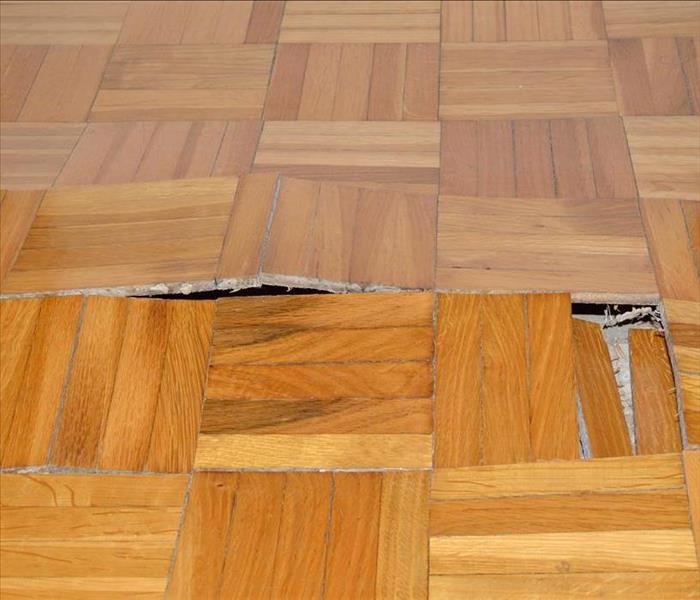 Wooden flooring was damaged by water.
Wooden flooring was damaged by water.
Tips For Detecting Water Damage In Your Home
Often unnoticed for days or weeks at a time, water damage is one of the most common and costly disasters within a home. By the time you notice it, it may be hard to salvage anything. However, you can avoid that situation. Here are some tips for detecting water damage and handling a flooded basement or a busted water pipe.
Look for Signs of Damage
Water damage can often be hard to detect. Sometimes, it's not until you start to see swelling wood or notice that your floor is wet that you realize something is wrong. Fortunately, there are other, more subtle signs of water damage that you can look out for to identify the issue much sooner.
- Peeling or blistering paint
- Loose wallpaper
- Mold and mildew in or on walls
- Rust on metal surfaces
- Corroded electrical wiring
If left unchecked, water damage can progressively weaken the structural integrity of your home and pose fire hazards around electrical outlets.
Check Your Water Supply Line
Floods, rainfall, or broken water pipes can all cause water damage. Start by turning off the water supply and repairing any broken water pipes. Swelling wood may indicate where the breaks are, making a water pipe repair easy to complete.
Fix the Damaged Areas
Depending on how long the water was left standing, wooden structures around your home may be warped or swollen. Drywall and solid wood can be dried and salvaged if the damage is detected quickly. You can use towels or a wet vacuum. Swelling wood, such as particleboard or wood composites in cabinets and the subfloor, may need to be replaced. If necessary, call a water damage repair service in Batavia, IL.
Water damage can be a hassle. Identifying the problem quickly and contacting professional services can help you mitigate the effects and restore your home.
5 Ways for a Business To Use Less Water
3/21/2022 (Permalink)
 Annual plumbing inspections can identify issues such as old or worn pipes.
Annual plumbing inspections can identify issues such as old or worn pipes.
Five Water-Saving Strategies for Businesses
Overuse and waste are the most significant water issues at commercial properties located in Geneva, IL. Inefficient bathroom fixtures, irrigation and cooling systems can drive up water bills at any building. Here are five ways to maximize the efficiency of water use and save money.
1. Switch To Low-Flow Fixtures
Old commercial toilets use anywhere from three to seven gallons of water per flush. Consider a water upgrade to low-flow toilets that use anywhere from 1.28 to 1.6 gallons per flush or urinals that use just 0.05 gpf or are waterless.
2. Adjust the Irrigation System
From installing sensors that detect rain or measure soil moisture to scheduling sprinklers to water less often for longer periods of time, there are several ways to reduce outdoor water waste. Irrigation accounts for a significant percentage of water usage at commercial properties with landscaping.
3. Avoid Pipe Breaks and Leaks
Annual plumbing inspections can identify issues such as old or worn pipes or corrosion build-up that can lead to water issues and leaks. A hidden leak can cause water bills to spike, and usage will not decline until the problem is fixed.
4. Maximize Cooling Tower Efficiency
Evaporation is a primary source of water use in buildings with cooling towers. Building owners may want to mix gray and potable water or otherwise recycle water to lower usage.
5. Reduce Water Booster Pressure
Buildings with more than a few floors may rely on water boosters to pump water up to higher stories. Try turning down the settings to conserve energy and water while lowering pipe pressure that could lead to breaks and water damage.
These measures may prevent common water issues at a commercial building in Geneva, IL. A property owner or manager may be able to make these upgrades with small initial investments that pay off over time and reduce risks of damage.
Precautions That Can Help Prevent Frozen Pipes
1/23/2022 (Permalink)
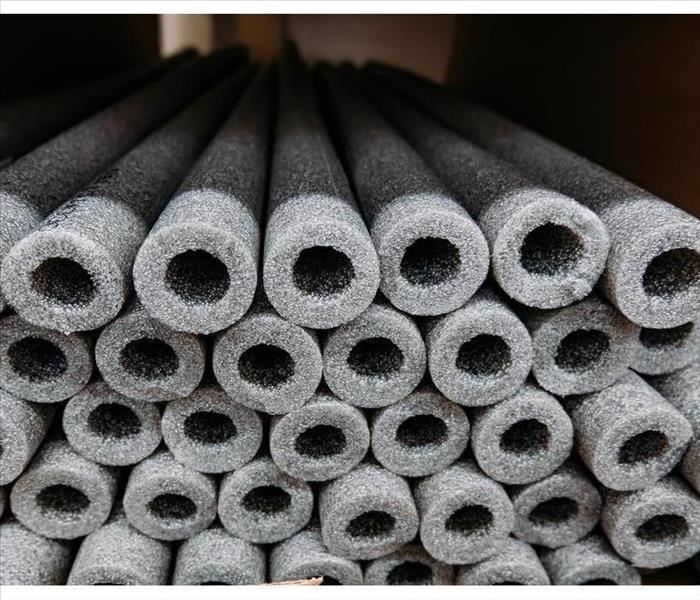 Insulate your pipes
Insulate your pipes
Prevent Frozen Pipes
With the onset of winter in Batavia, IL, there are many things to look forward to holidays, snuggling with cider and a good book, sledding, and a myriad of other frosty activities. Frigid winter weather, however, can wreak havoc on household plumbing. Unprotected pipes can rupture with the drop in temperature, leaving you with a wet mess and damage to your belongings or your structure. Frozen pipes can be prevented by taking a few simple steps.
How To Prevent Frozen Pipes
Securing your plumbing doesn’t have to be a chore. There are many basic strategies you can use:
- Insulate pipes and fittings with foam sheets or fiberglass
- Keep the surrounding room warm
- Leave cabinet doors open
- Turn faucets on to a slow drip or trickle
Evaluate your home to discover where you may need additional insulation to prevent a pipe freeze. For instance, kitchen, bathroom or laundry room plumbing fixtures on the outer wall will be more vulnerable than those located on an inner wall. Garage sinks or outdoor faucets with connected hoses are also prime areas for problems.
Make sure to set your home’s thermostat high enough to keep these rooms and areas warm. A space heater may help you achieve this. Opening the cabinet doors to expose water lines to warmth during extreme temperature drops can also prevent pipe freeze. Allow the faucets in these areas to drip or slowly trickle to keep the drains open and water flowing freely.
What To Do When Pipes Freeze
If frozen pipes do occur, call on restoration professionals in Batavia, IL, to help you save as much of your home and belongings as possible. They can assist you in drying out carpet and flooring, securing structural materials and initiating water cleanup to prevent mold or rot. Removing moisture properly can make the difference between restoring or replacing wet items. To stop water problems in the first place, be sure to follow the steps outlined above and enjoy the winter weather!
Tips for Cleaning a Clogged Drain
12/14/2021 (Permalink)
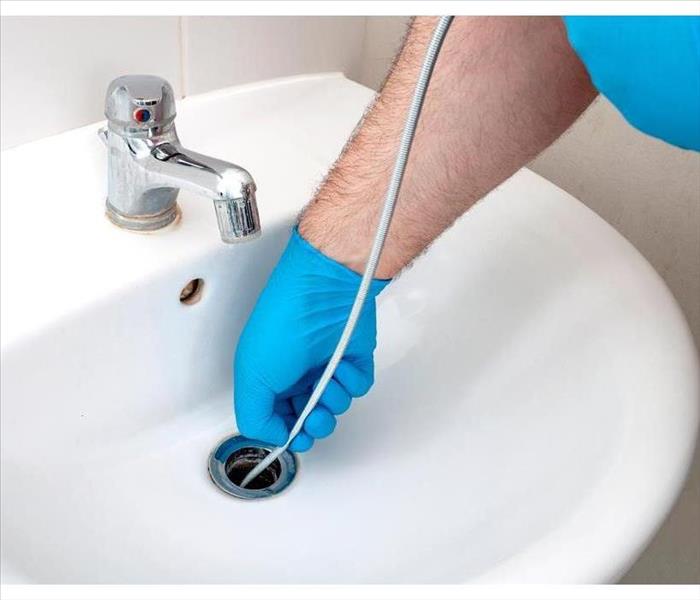 One useful tool for clearing a clogged drain is the drain snake.
One useful tool for clearing a clogged drain is the drain snake.
Finding a clogged drain in your Geneva, IL, home isn’t something most people look forward to. Fortunately, there are a number of ways to handle a situation like this. From clog prevention ideas to using a drain snake, here are a few things you may want to know.
How To Prevent Clogs
One of the first places to start is doing what you can to prevent clogs in the first place. Some steps you can take to avoid a stopped-up drain include:
- Use a sink strainer to prevent large debris from getting in the drain
- Use a hair trap for shower or bathroom sink drains
- Keep fats and grease out of your drains
- Don’t pour hardening materials, like plaster, down your drains
- Run cold water into the garbage disposal while in use
How To Use a Drain Snake
One useful tool for clearing a clogged drain is the drain snake. A drain snake is fairly straightforward to use. Simply insert the snake into the drain and turn the handle until you feel resistance which should indicate you’ve found the clog. Keep turning until you feel the clog loosen. Pull the snake out of the drain. The clog may be pulled out as well, or it may have been broken down. It’s best to run water into the drain for a few minutes to help finish flushing the system.
How To Take Care of a Broken Pipe
Sometimes a clog can lead to a sink overflow or a pipe break. When this is the case, you could end up with water damage in your home as well. A water damage professional can assess the situation, help you find the source of the problem, and help conduct repairs.
If you have a clogged drain, you may be able to clear it with a drain snake. Once clear you can prevent future problems by using a sink strainer. In the event the clog does lead to any water damage problems, a professional may be able to help.
Useful Information on Water Damage
11/29/2021 (Permalink)
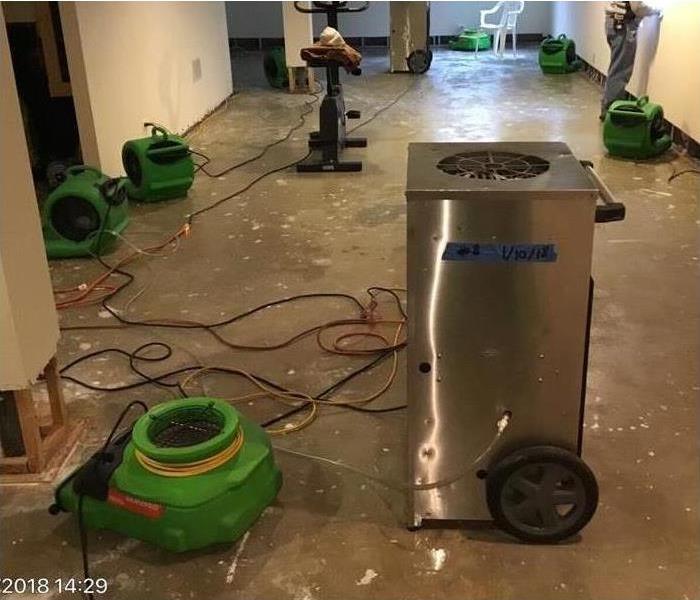 SERVPRO responded quickly to begin mitigation after a water loss.
SERVPRO responded quickly to begin mitigation after a water loss.
What To Know About Water Damage
Water damage is one of the scariest things homeowners can think of. Many of them know what water damage entails. However, a few understand exactly what causes it, how to repair the damaged parts and how to ensure it never occurs again. Below is a list of everything you need to know about water damage.
Common Causes
Water damage and flood damage may occur if excess water accumulates in areas where it is not supposed to be. Several factors can cause this excess water in your business or home. The most common factors include pipe break, issues with the plumbing system, faulty household items, natural disasters, leaky roof, supply line break and improper grading. Many of these issues are difficult to detect during the early stages. They only become known after they cause serious damages.
Removing Standing Water
Removing standing water in a flooded home is the first step towards water damage restoration. It is important to get rid of the accumulated water in the home or business as soon as possible to allow the flooded areas to dry. Do not attempt to repair the flood damage yourself. Hire a reputable restoration company to do the water cleanup job on your behalf. A restoration company has well-trained and qualified personnel who know exactly where to start from and what to avoid.
Most likely, the restoration company experts will use a pump or any other tool to do water cleanup. They will remove the water from the flooded home and check to see if the cause is due to a pipe break, supply line break, or any other plumbing issues that might bring water in your home.
6 Steps To Handle a Pipe Break
9/27/2021 (Permalink)
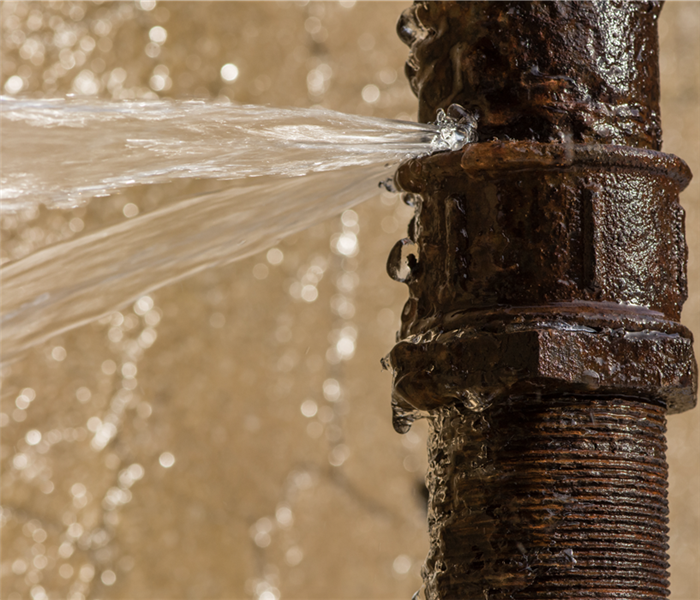 Follow these steps to deal with bursting pipes and water damage in St. Charles, IL.
Follow these steps to deal with bursting pipes and water damage in St. Charles, IL.
Bursting pipes can cause extensive damage in commercial property. There are several steps you can take to limit the extent of the damage.
1. Call a Plumber
Contact a plumber with an emergency work order to fix a broken pipe. If more than one person is on-site, one person should make the call while the other shuts off or collects water.
2. Shut Off the Water
Shutting off the flow of water to your building can limit the amount of water that can cause damage. Notify all occupants that the water is turned off.
3. Collect Water in Containers
Collect as much water from bursting pipes as possible in any containers you have on hand. Once again, if more than one person is present, you should cycle out containers as each becomes full. These containers will be heavy, and a sturdy cart may help prevent strain or injury.
4. Fix Broken Pipes
A plumber should resolve the source of the leak before you can start removing water and restoring the area. Continue to try to mitigate the damage until help arrives.
5. Eliminate All Standing Water
Use any method available such as buckets, mops, towels, or a wet vacuum to start getting rid of standing water. You may want to call commercial damage restoration professionals with specialized equipment to pump out water. Water from a burst pipe is clean Category One water. If water leaks through building materials to another floor, it becomes contaminated Category Two water.
6. Dry the Affected Area
Prevent mold or other secondary damage by completely drying the area affected by the leak. Use a dehumidifier to draw moisture out of porous or semi-porous building materials and contents.
Follow these steps to deal with bursting pipes and water damage in St. Charles, IL. A plumber can help stop the leak, and restoration experts can help prevent further damage.
3 Tips for Cleaning Up After Your Home Is Damaged by Water
8/27/2021 (Permalink)
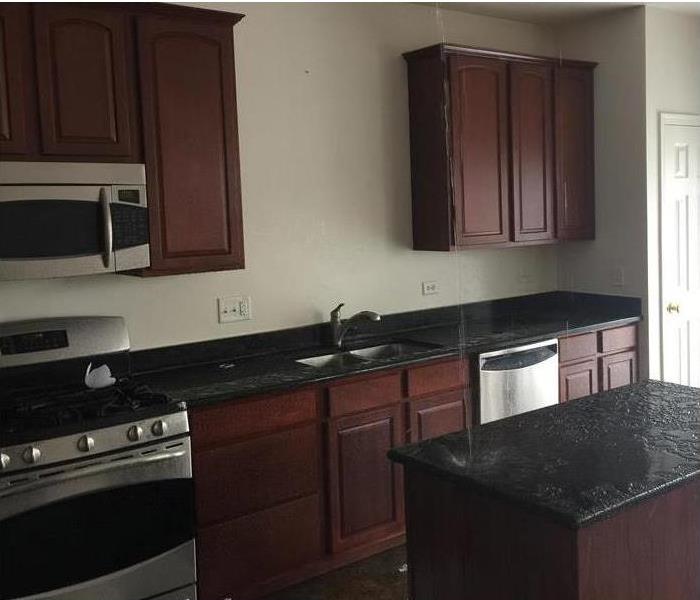 SERVPRO can help you with the cleanup process when you 're dealing with water damage in your home.
SERVPRO can help you with the cleanup process when you 're dealing with water damage in your home.
3 Cleaning Suggestions After Water Damage To Your Home
When you think of water damage, you might think of issues caused by heavy rains or hurricanes. However, your Geneva, IL, home can be affected by flooding as the result of a plumbing disaster or a failed water appliance, such as a washing machine or dishwasher. When this type of problem occurs, there are a few steps you can take to clean up the water and assess the damage.
1. Avoid Flooded Rooms
Water from your dishwasher or washing machine can contain detergent chemicals that might harm your skin, and a malfunctioning water heater may burst and give you serious burns. It is wise to shut off the water supply to the broken appliance and then seal the room until help arrives. Do not let anyone go into the room, especially if you know electrical systems might have been damaged.
2. Call in Restoration Services
A professional flood cleanup and restoration company can help get the cleanup process started when you are dealing with water damage. Flood technicians may assist with removing any remaining water and advise you on what kind of repairs you might need to make. For example, if broken pipes have caused a flood in your kitchen, restoration experts can help you understand whether wall sections or flooring can be repaired or if they will need replacing.
3. Sort Through Wet Items
Once the area is safe to enter, you can then take stock of water damage by retrieving wet items and sorting them. Dry what you can in a low-humidity area, out of direct sunlight, and then disinfect smaller objects. You may want to ask your restoration company which items are safe to keep and which you must throw away after the water cleanup.
When a water appliance breaks and causes a flood in your Geneva, IL, home, it can cause a variety of problems. However, knowing how to deal with water damage may go a long way in keeping you safe and preventing long-term harm to your home.
Why You Need a Professional Response to Home Flooding
6/23/2021 (Permalink)
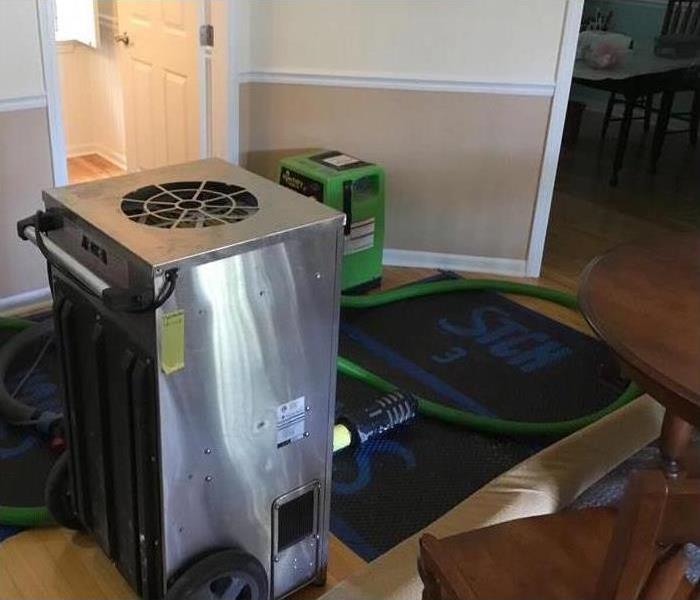 Drying equipment placed in a home.
Drying equipment placed in a home.
Residential Flooding
Once your St. Charles, IL, home has been exposed to flood damages, it's important to take steps to avoid secondary damage. This type of damage occurs when the materials of your home suffer because of indirect exposure to water or contamination. Some of the results include the growth of black mold or swelling wood floors. There are several common causes of this type of damage.
- Flooding wasn't cleaned up completely or soon enough.
- Type of dehumidification wasn't adequate for the circumstances.
- Areas of exposure were overlooked during the assessment phase of recovery.
Water Extraction Machines
If your home has been affected by flooding, your wet/dry vacuum, air conditioner, and fans won't have enough impact on the high humidity levels resulting from the presence of so much water. Professional extraction machines quickly remove water without giving it time to evaporate as quickly into the air of your home. The speed of water removal also decreases the chances of excess water getting under the walls and other hidden areas of the home.
Dehumidification Equipment
As water evaporates in the home, it will condense on parts of the home that hadn't initially been affected by the flooding. Porous materials, such as the wall materials, then become ideal for the growth of black mold. Professional-strength high-volume dehumidifiers are necessary to remove as much moisture from the air as possible, as quickly as possible.
Professional-Strength Fans
High-speed fans are also necessary to prevent standing water from seeping into the porous materials of your home and furnishing. Household fans could be used in a pinch, but if you have access to professional-strength fans, they are the best option.
Protect Your Home With Professional Results
As soon as your home has been affected by flooding, protect it, your furnishings, and your family from the effects of secondary damage. Reach out to flood restoration professionals with the equipment and training to prevent black mold, permanently damaged wood, expensive reconstruction, and all of the other damage that could occur. Check with your insurance company concerning flooding policies.
3 Times Homeowner’s Insurance Doesn’t Cover a Flooded Basement
3/15/2021 (Permalink)
 Your homeowner's insurance doesn't cover every type of water damage.
Your homeowner's insurance doesn't cover every type of water damage.
When Is Flood Not Covered?
Unfortunately, there are plenty of sources for a basement flood in your home in Elburn, IL, that your homeowner's insurance will not cover. The following sources are common examples of when the flood is not covered.
1. Storms
A basement flood from a natural disaster is generally not covered by your insurance. This means you should have a sump pump in your unfinished basement. If you have a finished basement, you should take other measures to keep water out. For all situations with rising water levels, flood insurance is your best bet. This type of policy offers insurance coverage for your personal belongings. In other words, they will pay to replace your items or have them dried by a water restoration company that offers content cleaning.
2. Sewage Backups
If sewage backs up and floods your basement, it will probably not be covered under a standard policy. This type of disaster is the most expensive and can cause a lot of damage. Fortunately, you can combat it by purchasing an additional clause on your insurance policy. Just make sure that you get at least $10,000 of coverage. Otherwise, they could leave you footing a lot of the bill for the restoration work.
3. Groundwater Seepage
A basement flood caused by groundwater seepage is generally not covered. You may notice these after heavy rain strikes as water seeps through the cracks in your foundation. Your insurance company considers this a non-coverable calamity. This is also typically not covered by flood insurance. The best way to prevent this type of disaster is to ensure that your foundation is solid. Also, reseal your basement walls periodically. This will prevent any water from entering, so you don't have to worry about paying for the damage.
Your homeowner's insurance doesn't cover every type of water damage. These are just some of the sources of a flooded basement that your insurance company will likely exclude from your policy.
Why Do I Need a SERVPRO Emergency READY Profile?
2/17/2021 (Permalink)
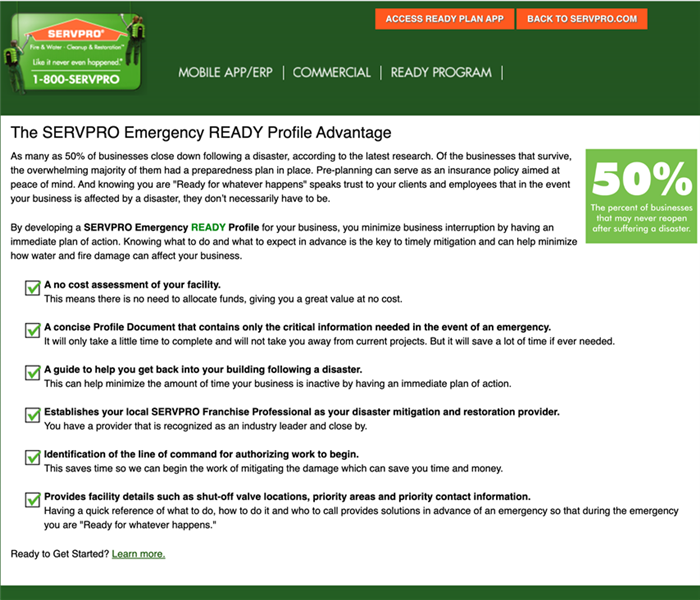 A SERVPRO Emergency READY Profile is an excellent way to minimize your downtime after a disaster.
A SERVPRO Emergency READY Profile is an excellent way to minimize your downtime after a disaster.
Is your business prepared if a disaster strikes? Sadly, for many businesses, the answer is no. Research indicates that nearly half of businesses that are affected by a disaster never reopen. Insurance is important, but it’s not always enough. Creating an emergency profile with an experienced restoration company can give your business a huge advantage if the unthinkable happens.
Why Do I Need a READY Profile?
After a disaster like a flood or fire, most businesses will need to remain closed until restoration work is complete. Every day that your business is closed is not only a day that you aren’t bringing in any money, but it’s also a day that your customers are looking elsewhere and a day that your competition is gaining an edge. Time is of the essence after an emergency, and anything that can help get your restoration underway more quickly can be a game-changer. A SERVPRO Emergency READY Profile is an excellent way to minimize your downtime after a disaster.
What Is a READY Profile?
Developing an emergency profile for your business has many benefits that can save you valuable time after a flood or fire. An ERP does the following:
- Identifies your chosen North Aurora, IL, restoration company
- Establishes key business contacts who can authorize work
- Consolidates important information such as insurance policy numbers and contacts into one convenient place
- Stores critical facility facts such as the location of shut-off valves
- Provides a custom action plan with the exact steps you should take in an emergency
How Do I Get Started?
To start creating your READY Profile, first go to SERVPRO.com/ready to register for an account and create a username and password. After you register, you can designate your preferred SERVPRO location and add information about your business. Then, download the ERP App onto your smartphone or tablet, and log in.
Don’t let your business become a statistic. Setting up an emergency profile before disaster strikes will help you reopen as soon as possible.
What You Should Know About Basement Flooding
1/11/2021 (Permalink)
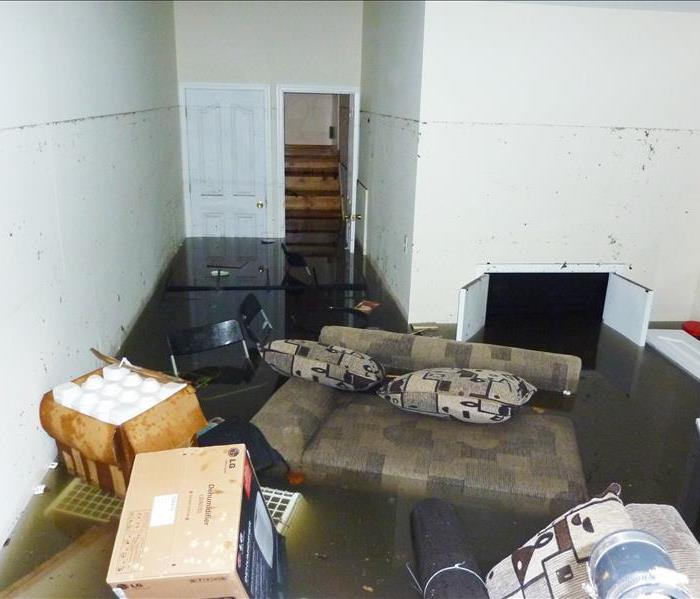 Flooded basement in Geneva, IL
Flooded basement in Geneva, IL
Basements and crawlspaces are spaces within your home that are most susceptible to damage from flooding. If you’ve experienced significant rainfall, burst pipes, or poor drainage around the house, you may find yourself dealing with serious water damage for your home in Geneva, IL. Cracks and holes in basement walls provide entry points for water to seep in and cause damage to the structure as well as any belongings.
Dealing With Basement Water
If you encounter water in your basement or crawlspace, it’s best to act quickly and consult a professional water damage restoration company. These providers can arrive fast to remove water damage and make sure your home is dry. Water damage remediation for your basement is likely to follow this basic process:
- Removal of water using specialized equipment
- Drying of objects and surfaces using advanced techniques
- Cleaning and disinfection of surfaces, including remediation of mold
- Examination and clearing of drains, gutters and downspouts
- Repair of objects and items damaged by water
- Repair and elimination of source issue, including leak and pipe repair
Getting the Big Picture
Professional water damage restorers not only have the tools, experience and knowledge to deal with a basement flood, but they’re also prepared to deal with the situation at any time of the day. Flooding in your basement is an emergency situation. Professionals act quickly to prevent further damage, ensuring that the source of the problem is resolved and that your home is dry. If items can be repaired instead of replaced, these experts know the best way to restore and recover impacted belongings, including furniture, documents and other valuables.
Flooding presents a serious issue for any basement or crawlspace in a residence. There’s no job that’s too big or too small for water restoration specialists to quickly address. A DIY approach probably isn’t comprehensive enough to bring your basement to pre-damage conditions.
Are Broken Pipes Covered by Insurance?
11/30/2020 (Permalink)
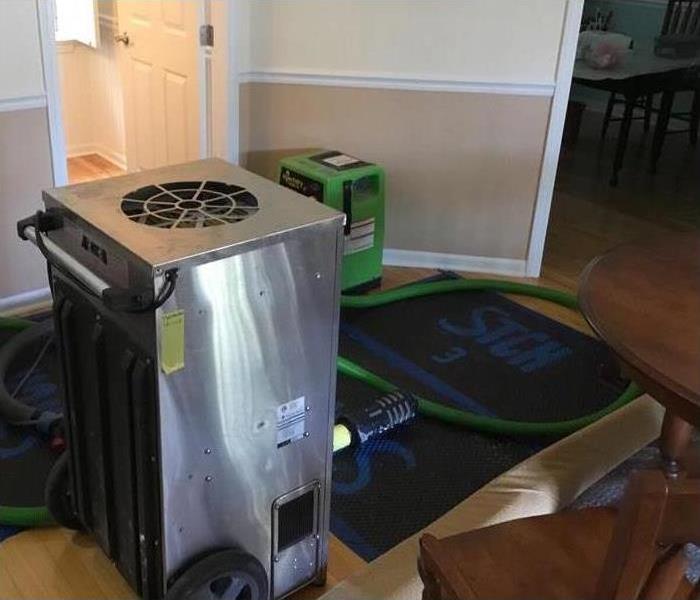 Water damage restoration services
Water damage restoration services
SERVPRO Is Here To Help!
If a pipe suddenly breaks in your home, causing a flood, there’s an excellent chance that your insurance will cover the resulting damage. However, you have a duty to act quickly, and if you ignore routine maintenance or an ongoing issue, your claim can be denied.
What Is Excluded by Insurance?
Insurance coverage is designed to handle accidents beyond normal use. It’s not meant to protect homeowners who are negligent in maintenance and those who ignore obvious problems.
Common exclusions from coverage include:
- Poor maintenance
- Ignoring a known issue
- Water damage from a flood outside the home
- Earthquakes and sinkholes
- Normal wear and tear
For instance, if there’s a leak and you don’t fix broken pipe or connections, it won’t be covered if the insurance company finds out. Also, while earthquakes aren’t covered, the damage from other earthquake-caused problems, such as fires, may be fully covered.
What About a Slow Leak?
Gradual damage can be a tricky issue. Generally, damage incurred over a long period is not covered, but the wording on your policy makes a huge difference. If the gradual water damage was caused by something the homeowner knew about – or should have known about – it won’t be covered.
Another factor is the nature of the damage. Was it caused by a sudden event? If an accident happens that’s hidden for a reasonable period of time before being discovered, and that accident created a situation causing gradual damage, it may be covered.
What About Black Mold Damage?
This is an example of slow damage. Whether it’s covered by your policy will depend on the policy wording and cause. Many homeowner’s policies don’t include mold at all, so it’s really hit or miss with mold. A flood is also always excluded from standard insurance coverage.
What Should You Do if You Discover a Slow Leak?
You need to immediately shut off the water to the area and call your top local water damage restoration company to perform an initial inspection. They can mitigate further damage, help you with insurance claims and begin the repair process.
How to Repair a Leaky Toilet
10/8/2020 (Permalink)
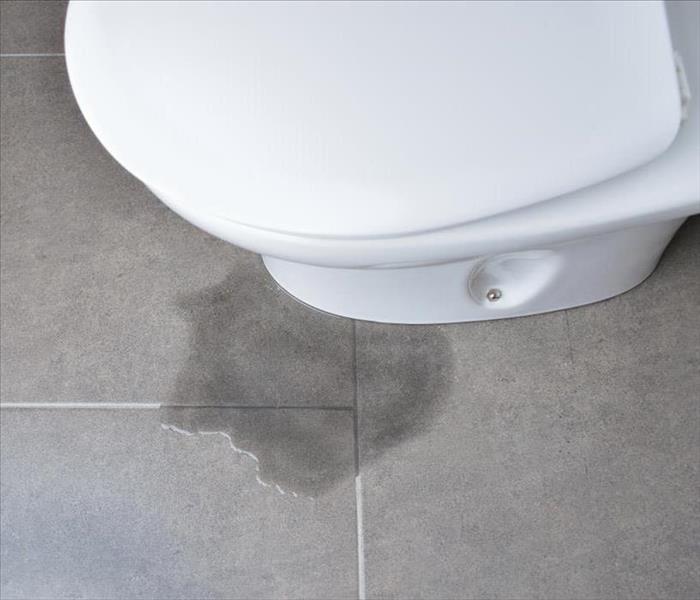 A leaking toilet is a relatively easy household repair to make
A leaking toilet is a relatively easy household repair to make
A toilet is a very durable, reliable household fixture that is able to last for decades without too many issues. That being said, even the hardiest of toilets can still succumb to leaks from time to time. Follow the steps below if your house in North Aurora, IL, has a leaking toilet.
Step by Step Toilet Repair
Luckily, repairing a leaky, old toilet is a relatively easy process, even if you don't have any experience with plumbing.
Use a wrench to disconnect the supply tube from the shutoff valve. Double check to make sure all the water is drained from the bowl and tank in the leaking toilet.
At the base of the toilet, remove the rounded caps that cover the closet bolts. Remove the hex nuts using a wrench.
Grasp the toilet by the bowl and carefully lift, using your legs. Set the toilet down on an old blanket or cardboard sheet to prevent water damage on your bathroom tiles.
Go to the closet flange and scrape off the old wax gasket. Inspect the closet flange for damage. In most leaky toilet repair cases, a section of the closet flange is broken off.
Loosen the screws that secure the flange to the floor and slide a repair strap underneath it.
Center the new wax gasket on the closet flange. Both closet bolts should be in place during this step.
On the bottom of the tank, connect the new water supply tube to the threaded fill-valve shank.
Apply downward pressure on the rim of the toilet bowl to compress the gasket. Tighten the nuts and apply more pressure.
Trim the tops of the closet bolts using a close-quarter hacksaw. Tighten the nuts and replace the caps.
Reconnect the supply tube to the shutoff valve. Open the valve and flush the toilet. Carefully inspect the new toilet for any leaks.
A leaking toilet is a relatively easy household repair to make. If the above process does not fix the leak, contact water remediation experts for further assistance.
Choosing Business Insurance for Water Damage: 3 Tips
9/3/2020 (Permalink)
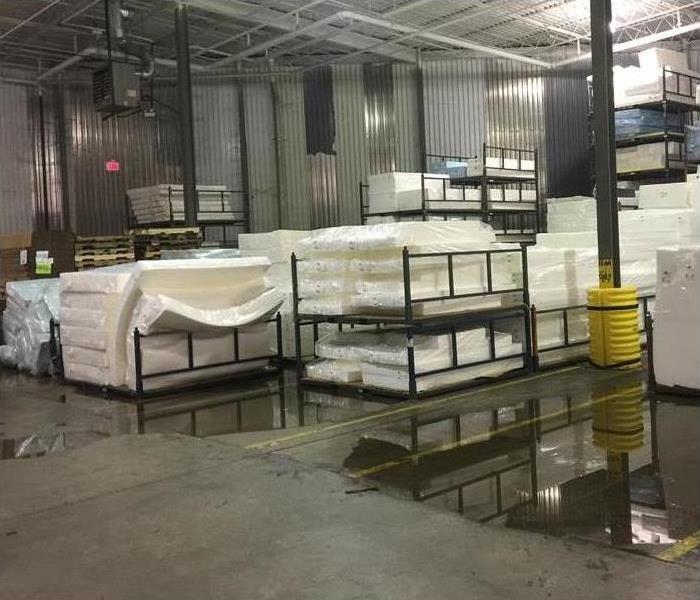 Water damage at a warehouse building in Elburn, IL
Water damage at a warehouse building in Elburn, IL
Keep In Mind The Following Three Tips
Protecting your Elburn, IL, business from the ravages of water damage due to both indoor and outdoor flooding can help you avoid financial stress and safeguard your investment. Business insurance offers protection against many different types of flooding, but before you sign a policy, there are a few tips you may want to keep in mind to make an informed choice about the kind of protection you choose.
1. Coverage May Vary
While business insurance may cover certain types of flooding, it may not offer an all-encompassing blanket of protection. For example, your insurance might cover flooding from broken pipes, but if your business suffers damage from outdoor flooding or a sewer backup, you may have to pay out of pocket for it. Asking your insurance representative about these exceptions may help keep you in the know and give you peace of mind if flooding does occur.
2. You May Need Additional Coverage
A single business insurance policy may not offer you the kind of coverage you need because of the many ways water damage might occur. Ask your insurance representative if you require any addendums to your policy and if your commercial property has any features that might make it at higher risk for flooding, such as its location
3. Ask About Cleanup Coverage
If a flood occurs at your business, you might need a water cleanup and restoration service to remove standing water and remove and replace damaged building materials. As you create a flood insurance policy with your insurance representative, you may want to inquire about whether the policy you choose covers this cost. Because flooding can cause such widespread damage, this type of coverage may help you minimize the cost of flood recovery.
Water damage can have a serious impact on your Elburn, IL, business. While investing in business insurance can protect your investment, keeping the previous tips in mind may help you create a policy that offers a wide range of flood coverage.
How Long Do Supply Lines and Other Household Pipes Last?
6/1/2020 (Permalink)
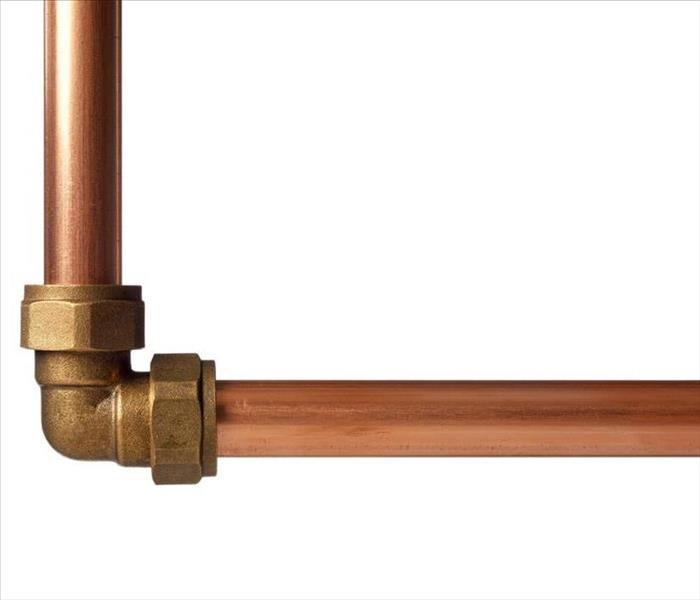 Copper, brass, and steel pipes can each be expected to last at least 70 years
Copper, brass, and steel pipes can each be expected to last at least 70 years
How Long Do Supply Lines and Other Household Pipes Last?
Supply line damage can occur in older houses. This, in turn, can lead to a variety of water problems. You could end up with a bathroom leak or a large flood.
Supply lines face constant pressure from flowing water. They can be made of several types of materials, including:
Thankfully, while these supply lines can experience wear and tear, you likely won't have to replace them completely. That's because they typically have long life expectancies. Copper, brass, and steel pipes can each be expected to last at least 70 years.
If you do discover standing water in your Batavia, IL, home following a supply line leak, your warranty may cover the cost of replacing the pipe. The length of your warranty also depends on the material used to make the pipes. Plastic pipes typically have a warranty that lasts five to eight years. Steel-braided pipes, however, often feature lifetime warranties.
While supply line damage may be rare, other pipes in your home are not quite as durable. Below are the life expectancies of various water lines.
Drain Lines
Drain lines can easily be damaged by weather or tree roots. While cast-iron pipes can last up to 80 years, plastic ones are less durable. They could break down in just 25 years.
Faucets
Most people replace faucets for purely cosmetic reasons. However, if you have frequent problems with your sinks, you may want to purchase new faucets.
Washing Machine Hoses
Washing machine hoses get damaged easily and should thus be replaced every three years. You should also regularly check the hoses for cracks or bubbles. These could be signs that a repair is needed.
Supply line damage is primarily an issue in older homes. However, harm to other pipes is more common. Any small cracks or holes in your pipes should be fixed immediately before they cause a major flood that necessitates water damage repair services.
A 5 Step Sprinkler Preparation Checklist
5/13/2020 (Permalink)
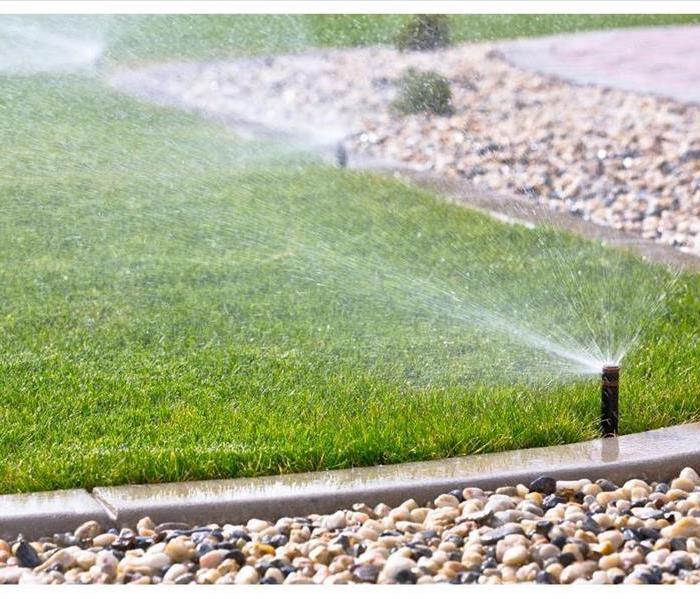 Commercial irrigation systems require seasonal irrigation maintenance to operate efficiently
Commercial irrigation systems require seasonal irrigation maintenance to operate efficiently
Take These Five Steps To Prepare a System for Operation
Commercial irrigation systems require seasonal irrigation maintenance to operate efficiently. One of the most critical procedures should occur as temperatures start to rise during the spring in St. Charles, IL. Property owners can take these five steps to prepare a system for operation.
1. Check the Soil
Sprinklers should not operate while the ground remains frozen. Lines running through frozen ground are prone to develop frozen blockages that raise pressure levels and cause pipes to burst. Check the status of the soil before activating and testing an irrigation system.
2. Clean the Heads
The heads on sprinklers are at risk of sustaining damage while installed. These components require regular irrigation maintenance, as debris can accumulate and block the flow of water or parts such as nozzles, filters, spray heads or rotors may be faulty.
3. Fill the Main Line
Water must enter pipes before a system can be tested. Slowly open the water main to allow time for pressure to equalize. Gradually introducing water safely pushes out air that could otherwise cause pressure levels to spike, resulting in broken pipes and water damage.
4. Test Zone Mains
Once the main irrigation line has been filled, it is time to test the integrity of smaller pipes. It is necessary to run water to each zone for at least a few minutes to check the functionality of every part of the system and detect any signs of sprinkler flooding.
5. Inspect the System
Allow the entire system to run and continue the inspection. It is also a good idea to adjust the watering schedule and ensure that soil moisture detection or rain shutoff devices are in place.
Commercial property owners should contact sprinkler system specialists regarding equipment malfunctions or irrigation maintenance issues. If an irrigation system leaks, restoration may be necessary to limit primary and secondary damage to a commercial property in St. Charles, IL.
Ideas on How to Avoid Frozen Pipes While on Vacation
2/19/2020 (Permalink)
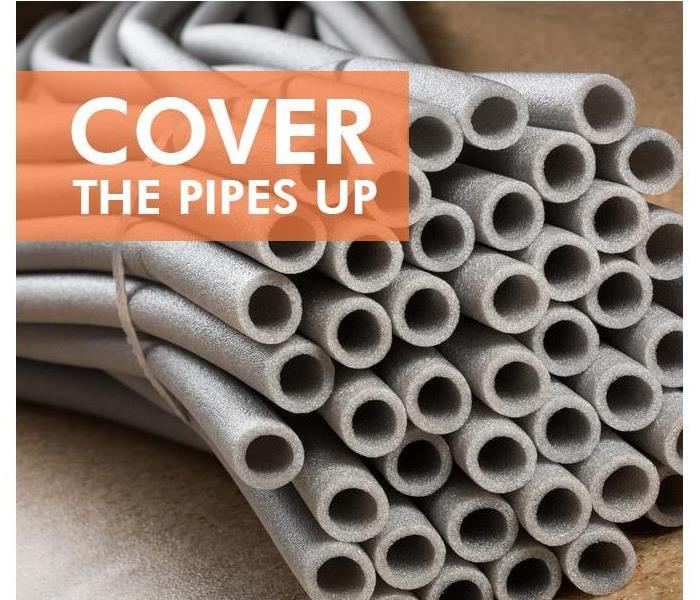 Insulating your water lines is probably the best thing to do before leaving for vacation
Insulating your water lines is probably the best thing to do before leaving for vacation
How To Prevent Freezing In Your Pipes
When temperatures plummet, pipe freeze becomes the leading cause of water damage in North Aurora, IL. Water lines in unheated parts of the house succumb to the surprisingly forceful pressure of solidifying water, causing thousands of dollars worth of water damage. That’s why you need to know how to prevent freezing in your pipes
Pipes with the highest risk of freezing include:
- Any line passing through the attic
- Pipes in the basement
- Supply lines in the garage
Insulate Your Pipes
Insulating your water lines is probably the best thing to do before leaving for vacation. It will mitigate the risk of frozen pipes, saving you the trouble of continually heating the pipes.
There are several options for plumbing insulation in the market today; some are dirt cheap, while others are not. Inexpensive options such as rubber and fiberglass, are suitable for houses with decent insulation. There’s also an electric heating tape that can work for any situation.
Turn on the Heat
Leaving the heat on might not be the most economical thing to do, but maintaining 55F or more can prevent freezing in plumbing fixtures. Ask a friend to check the house regularly to make sure it is warm enough. It’s one way of avoiding a nasty pipe burst incident.
Shut off the Water Supply
Cutting off the water supply at the main valve has its pros and cons. First, it will prevent any water from getting into the system, which eliminates the risk of frozen pipes. However, fire sprinklers will not work if they are needed. That’s why some people prefer leaving their faucets dripping to reduce pressure and eliminate the risk of freezing. With these tips, you will never have to worry about frozen pipes ever again. You can implement any of them and get the desired outcome, but they work better when used together. For example, insulate the pipes as the first thing then have a friend check-in every other day for the best results.
How to Handle a Sewer Overflow Like a Pro
2/3/2020 (Permalink)
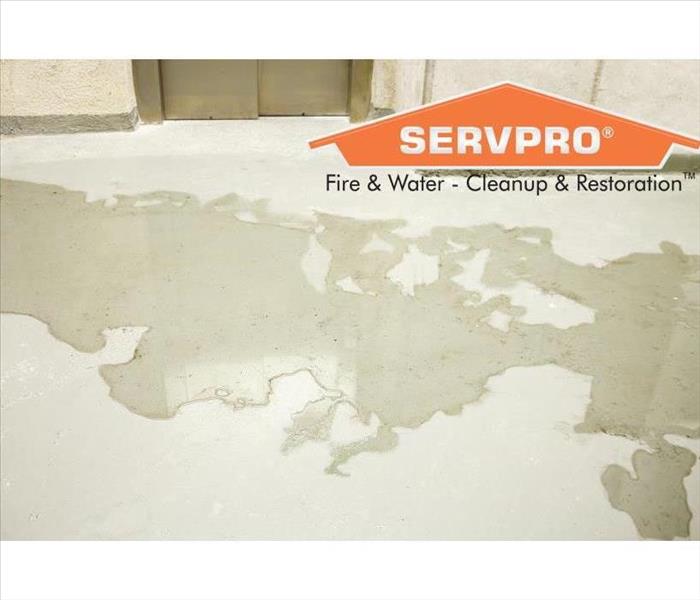 Call a professional restoration company to cleanup a sewer damage.
Call a professional restoration company to cleanup a sewer damage.
A sewer backup is probably the worst thing that could happen to a property owner. Whether it’s a sink or toilet overflow, the overwhelming number of bacteria and harmful viruses in black water can cause severe infections to people. So, here is a wastewater cleanup guide for people in Batavia, IL.
Preparing for a Sewer Cleanup
The first thing to do when dealing with a flooded toilet is gearing up for the job. The protective attire needed for this task include:
- Rubber gloves
- Eye protection
- Waterproof boots
- Impervious overall
The idea is never to touch fecal matter directly, no matter the situation. It is the only way to avoid allergic reactions and nasty infections. Also, you might want to bring bin bags, brushes and mops to help with the actual sewer cleanup exercise.
Getting Started
After wearing protective clothing, scrutinize the situation before starting the operation. Then decide if you should switch the electricity off or leave it on to help with air circulation (fans, air conditioners, and dehumidifiers).
Shovel most of the solid waste into double bin bags to prevent more disasters. Then use a mop and bucket to remove the remaining slurry. If you use any power tools in this step, be sure to wear a gas mask to avoid sewage-contaminated air.
At this point, you should have already identified things that are not salvageable. Carpets, for example, are notoriously hard to disinfect and should be discarded. Clean up everything else with hot water and detergent. However, get a second opinion from a professional cleaner before trashing expensive things.
Sewer cleanup is not an easy task by any chance, but it’s necessary if you want to remain in business. Even so, be very careful with sanitation, and don’t think twice about throwing things out. If you do this job right, everything will go back to normal in a few hours.
3 Tips for Preventing Frozen Pipes
12/12/2019 (Permalink)
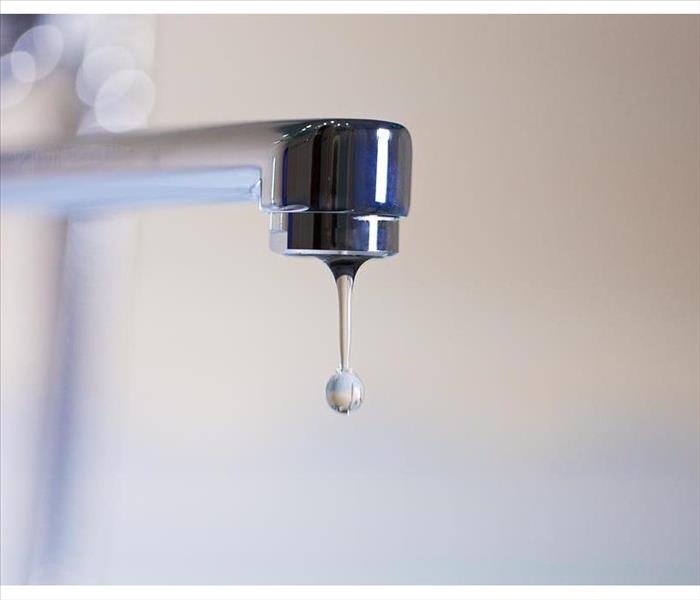 Letting faucets drip warm water overnight can create a trickle that keeps your pipes just warm enough to fight off freezing
Letting faucets drip warm water overnight can create a trickle that keeps your pipes just warm enough to fight off freezing
The winter season can bring many joys, but also headaches in the form of frozen pipes. A pipe freeze can trigger a catastrophic chain of events in your home that can end in big bills. Many homeowners don’t realize this can be avoided. Check out these tips for keeping your Elburn,IL, home’s pipes toasty as temperatures drop.
Why Do Pipes Freeze?
It may seem obvious why pipes freeze: They’re full of water, which forms ice when temperatures drop. But that’s not the top reason for frozen pipes. There are actually three main triggers. Those are:
- Quick temperature drops
- Poor insulation
- Thermostats set too low
While you can’t change the temperature outside, you can definitely prepare your pipes and keep them from being negatively impacted.
Insulate Your Pipes
An exposed pipe is an at-risk pipe, even in parts of the country where freezing temperatures are rare. Fight back by insulating pipes during the warm season. Pipe insulation is available relatively cheaply at the average hardware store. Wrap pipes in your attic, crawl spaces and other areas where the temperature drops to prevent a freeze.
Seal House Leaks
Another threat to pipes comes from cold air that leaks into your home. Caulk up leaks around dryer vents, electrical outlets, and windows. These tiny openings can let in just the right amount of cold air to trigger a pipe freeze and all the headaches that come with it.
Drip Your Faucets
This may be an old trick, but it’s an effective one. Letting faucets drip warm water overnight can create a trickle that keeps your pipes just warm enough to fight off freezing.
Frozen pipes can trigger a pipe burst and with it, everything from flooding to household mold. Stop the problem before it starts. Use the above tips from your local water cleanup specialist to keep your home plumbing safe and secure through the season.
The 3 Types of Wastewater in Your Home
10/15/2019 (Permalink)
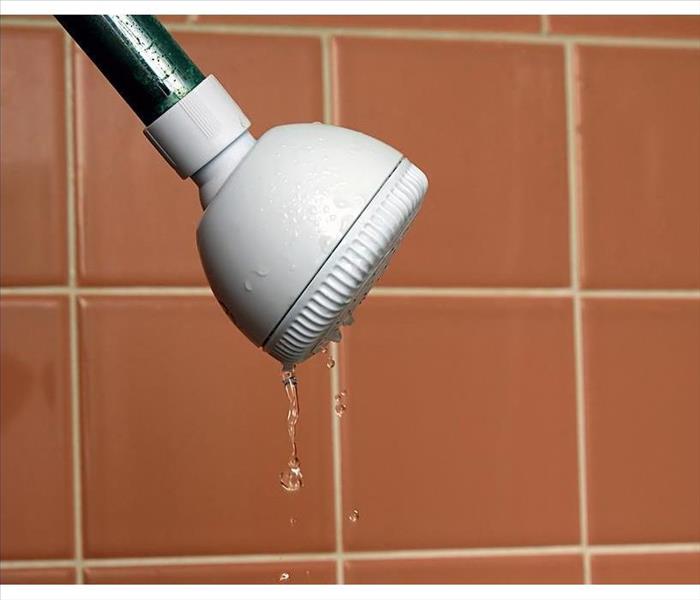 A dripping shower head is an example of clear water
A dripping shower head is an example of clear water
The 3 Types of Wastewater in Your Home
Every homeowner should know the basics of contaminated water in Geneva,IL. It could mean the difference between using a bunch of towels or calling in a professional water damage remediation specialist.
Clear Water: Category 1
This lowest category is water that hasn't been used yet- it's clean water that has come into your home and escaped its confines before it's intended use. This means that it is safe for you to clean up, if the damage isn't too great and you know what you are doing. Keep in mind that if left sitting for too long, category 1 water can become category 2 water in about 48 hours, depending on temperature and setting. Some examples of clear water are:
- Broken water supply line
- Leaking faucet
- Dripping shower head
Gray Water: Category 2
Category 2 is water that has been lightly used, and is only considered slightly contaminated water. It can cause slight discomfort to those who come into contact with it. Some common sources of gray water are dishwasher overflow, washing machine overflow or toilet overflow (with no feces). This type of water can quickly degrade into category 3 if left untreated, because there may be bacteria or viruses sitting in it.
Black Water: Category 3
The third category, black water, is the most dangerous to you and your family. You should avoid contact with this type of water at all costs. If you must interact with it, be sure to wear protective gear such as tall boots and long rubber gloves. This type of water usually comes from sewage backup, and can contain feces or microbial growth. River and stream overflow also fall into this category.
If you've discovered accumulated water in your home, do your best to identify the category of water before moving forward. When in doubt, avoid contact and call the professionals. Don't forget to take care of it as soon as possible to prevent the water from becoming more contaminated and more damage occurring.
Why Does Your Toilet Leak Every Time You Flush?
8/30/2019 (Permalink)
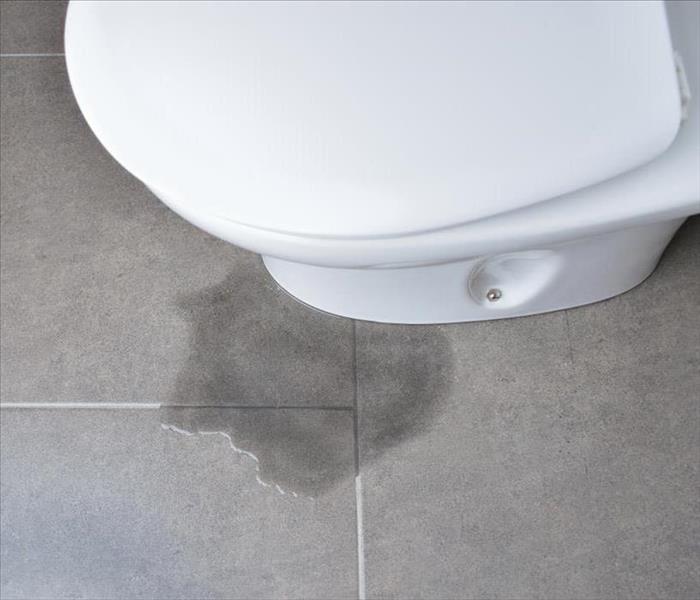 Water pooling in the base of a toilet
Water pooling in the base of a toilet
Common Causes Of A Leaking Toilet
Although it may seem like a mere annoyance, a leaking toilet should be taken seriously. To avoid the larger issues that water damage can cause in Batavia,IL, it is advisable to address the malfunction head on. There are several common causes of such a leak.
Faulty Wax Ring
One reason you may find water pooling at the base of the toilet is that the wax seal between the toilet and the floor has dried or was improperly installed. Even for someone with no plumbing experience, it is simple to replace the wax gasket to fix your bathroom leak. Just follow some simple steps:
- Turn off water and flush toilet to drain
- Unhook supply line and remove any bolts
- Rock toilet back and forth to loosen seal and gently lower it on its side
- Scrape off old wax from toilet and flange
- Place new wax ring on flange and put toilet back into place
Broken Flange
Another possible culprit for a leaking toilet is the flange. If it is broken, you can fill in the missing piece with a repair strap. First you need to loosen the screws that secure the flange to the floor. Then you will need room to slide in the new strap under the flange. Finally, re-tighten the screws and install the final closet bolt. If the flange is bent, or too damaged to repair, you can also reinstall a full replacement flange.
Degraded Supply Tube
You will also need to remove your toilet to check the status of your supply tube. If it appears damaged, you will need to replace it. Even if it isn't damaged, you should also consider replacement if it is made of chrome-plated copper, as they aren't very durable. Flexible stainless-steel polymer supply tubes last much longer than any others on the market and they are easier to manipulate when reinstalling your toilet.
It is best to solve your leaking toilet problem before you need to call water damage remediation specialists. It may seem daunting, but it is a good idea to get to know your plumbing as a homeowner.
How To Clean Up After Your Water Heater Breaks Down
6/13/2019 (Permalink)
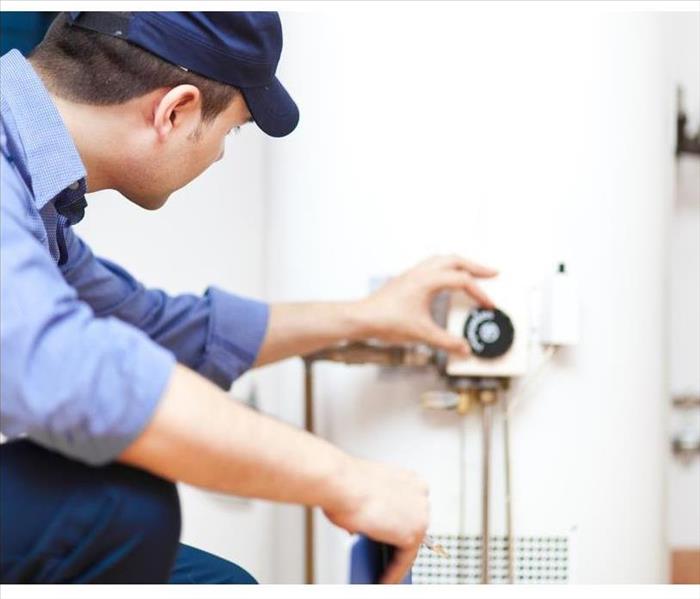 A leaking water heater can cause water damage in your North Aurora home
A leaking water heater can cause water damage in your North Aurora home
A water heater that has stopped working properly can cause damage in your North Aurora,IL, home, which must be addressed immediately. Before you contact a water restoration specialist, there are several steps that you need to take to keep the damage under control. Follow these guidelines to quickly mitigate the effects of a leaking water heater in your home.
Remove Excess Water
It’s crucial to first get rid of any excess water in your home before it spreads and damages your belongings. Start by mopping and blotting all areas around your house that water has seeped into. Be sure to also wipe away any traces of water that may be found on various items and surfaces, such as:
- Wood furniture
- Tabletops
- Floors
- Areas around your water heater
The damage caused by excess water from your failed water heater can be hiding in many places throughout your home. Make sure to remove as much leaking water as you can until help arrives.
Move Objects
Once you’ve taken care of any leaking water that could cause immediate damage, survey your possessions and keep them protected from the effects of your leaking water heater. Pick up all loose objects from your floors and move any artwork to a drier area where it will be safe. If any of your cushions have gotten wet, remove them as well and keep them propped up.
Contact a Professional
While you’re trying to prevent further damage to your home from your broken water heater, only do what you can. For the safety of your house, it’s best to call a professional and allow him or her to securely restore any water damage. The advanced methods that specialists use can help to keep any excess water at bay and protect your home.
Water damage from a leaking water heater doesn’t have to become a burden. With the right procedures, you can be one step closer to a restored home.
3 Common Sewage Problems in Commercial Buildings
4/17/2019 (Permalink)
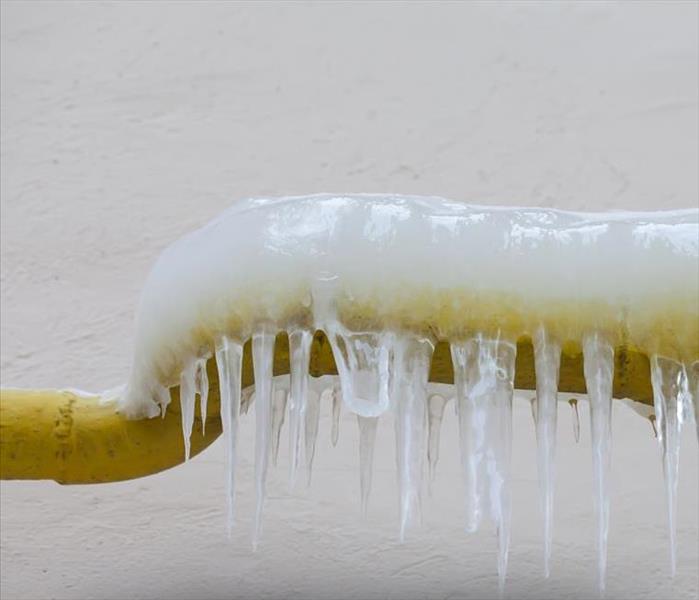 Frozen pipes are common, the damage is sudden
Frozen pipes are common, the damage is sudden
Finding sewage problems in your Elburn, IL building can be frustrating. If you are not careful, issues such as a blocked sewer can seemingly come out of nowhere. It is important to perform regular inspections and maintenance of the building in order to prevent any potential damage. The following are a few common problems that you might experience.
1. Broken Pipes
Pipe breaks are not always preventable. In some cases, such as cold weather when frozen pipes are common, the damage is sudden. However, old pipes often break as the result of normal wear and tear on the materials. If the pipes in your building have not been replaced in a while, you should be sure to check them regularly to catch signs of damage early.
2. Backed Up Plumbing
When you have a clogged drain, the water is removed very slowly and sometimes gets backed up. This can cause problems such as sink or toilet overflow. Not only will this be unpleasant to clean up, but it can also create lasting damage if it is not repaired quickly.
3. Sewage Blockages
Plumbing backups are not the only problem that can come from a clogged drain. If you are having trouble with more than one sink or toilet, it is likely that there is a larger issue. A blocked sewer can be the result of buildup in the drains that remove water from your building. This can be caused by disposing of items improperly, such as flushing paper towels down the toilet or pouring grease into the sink. In some cases, it may also be caused by the roots of nearby trees or a collapsed pipe.
While regular maintenance can help prevent certain sewage problems, sometimes they are unavoidable. If you have a blocked sewer or other problem, a damage restoration company can help locate the source of the issue and repair any damage that has been caused.
How To Deal With Frozen Pipes
3/15/2019 (Permalink)
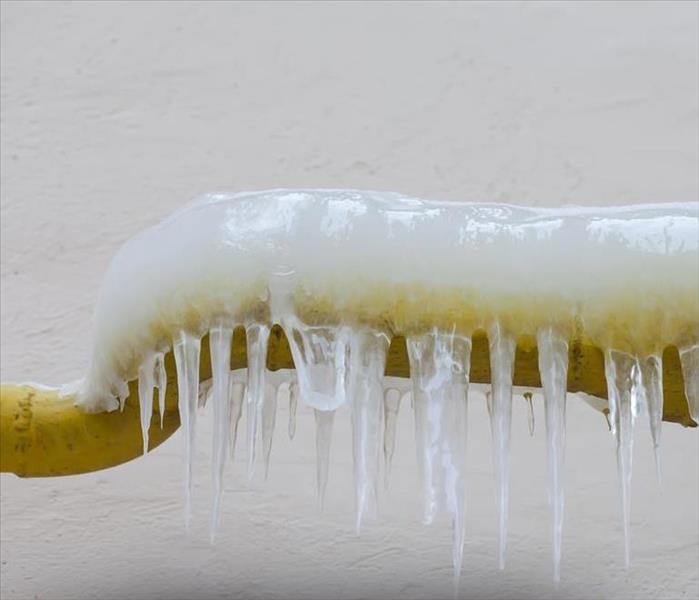 Frozen pipes que cause damage to your Geneva, IL home
Frozen pipes que cause damage to your Geneva, IL home
Winter weather can cause a lot of damage to your home. Prepping for winter means making sure there are no weak areas in your roof, around your windows or in your foundation to let cold air or water in. Other hazards to look out for are frozen pipes. While the best protection is prevention, there are things you can do to salvage pipes before they wreak havoc on your home.
Locating Problems
A pipe freeze will often show up as a faucet that produces little to no water flow. If that happens, start by inspecting pipes in the following areas:
- Near exterior walls
- In the attic or basement
- In crawlspaces
If there is frozen water in a pipe, it may have already expanded enough to crack. If that is the case, turn off the water main and call a plumber. Warming the pipe up before it's fixed may result in water damage that can only be resolved by water restoration specialists.
Unfreezing Pipes
Sometimes, frozen pipes won't show any signs of stress or breakage. When this happens, you can fix the problem by simply warming the pipe. Keeping faucets open to keep warm water moving through the pipes can accomplish this goal. You can also use a hair dryer to warm up pipes or, if the pipe is metal, a heat gun. Directing warm air from your HVAC unit into the walls can also unfreeze the water in the pipes.
Preventing Freezes
To prevent a pipe freeze, you want to make sure the pipes and the air around them stay warm. Insulate pipes that are particularly vulnerable. Keep the heater on in your home, and circulate the air so that it reaches the pipes. Opening cabinets and closet doors can help facilitate this circulation.
Frozen pipes can cause damage to your home in Geneva, IL, but dealing with this issue is fairly simple. By warming pipes and keeping them that way, you can prevent a lot of water damage.
3 Potential Reasons You Have Noisy Pipes
1/18/2019 (Permalink)
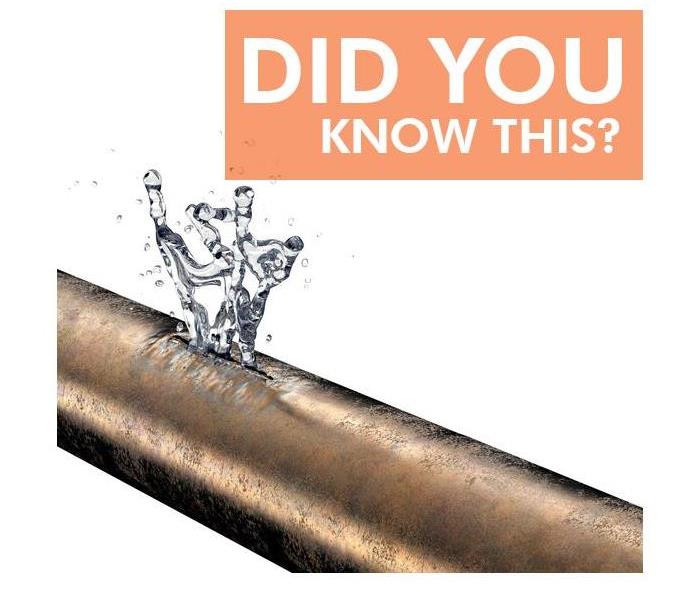 Copper pipes tend to expand when hot water passes through them.
Copper pipes tend to expand when hot water passes through them.
Noisy Pipes In Your Home
Your home in St. Charles,IL , should be a comfortable and quiet place. If you have a noisy plumbing system, though, knocks and creaks could keep you up at night. While avoiding a pipe break is likely your primary concern, you may want to quiet your loud pipes. Here are three potential reasons you have noisy pipes in your home.
1. You Have Copper Pipes
Copper pipes tend to expand when hot water passes through them. When you switch to cold water, copper pipes quickly contract. This expansion and contraction can make your plumbing system noisy. While you probably don’t have to worry about a pipe burst, the noise may annoy you. By lowering the temperature on your water heater, you may be able to effectively stop the creaks and pops.
2. A Water Hammer Hits Your Valve
A water hammer occurs when pressured water hits the shut-off valve. Unlike noises from copper pipes, a water hammer may cause a pipe break. You may be able to fix the problem by tinkering with the air chamber in your plumbing system. If the water hammer causes a break, you must fix the broken pipe. Then, work with a water cleanup service to be sure you successfully control flood damage.
3. Water Pressure Plagues Your Plumbing System
Finally, you may have too much water pressure surging through your pipes. While high pressure is good for washing dishes, filling water bottles and showering, it can wreak havoc on your plumbing system. If you think water pressure is the source of your noisy pipes, adjust the pressure regulator.
Noisy pipes can be unbelievably annoying. Depending on the cause of pipe noise, your loud pipes could be a sign of a bigger problem with your plumbing system. By understanding what causes pipes to creak, moan and snap, you can develop a plan for protecting your home’s plumbing.
Water in Light Fixtures? Safety First!
12/19/2018 (Permalink)
 Water in a light fixture in a St.Charles home
Water in a light fixture in a St.Charles home
Unless you live in a clam shell in Triton’s kingdom under the sea, you shouldn’t see water in your light fixtures. When your home is in St. Charles,IL, water in such a place is a dangerous problem that needs to be addressed quickly. Here are some important things to do to resolve the problem and prevent further damage.
Stay Safe
When it comes to water in a light fixture, your first step is safety. Here are three things to do to keep everyone safe:
1. Turn off electricity. Throw the breakers for the affected locations. If you are in doubt, turn off power to the whole house before proceeding.
2. Cordon off unsafe areas. You may have some ceiling damage, so look for sagging ceilings or stains to indicate its location and take caution until you find the source of the leak. Prevent children and other family members from being under or above the damaged area.
3. Stop the leak. Finding the leak may be a challenge, but once you have the electricity off, you can proceed without risk of electrocution. Turn off the water supply to prevent further damage until you can repair the source of the leak.
Prevent Secondary Damage
A sneaky ceiling leak causes a lot of damage. You may need a professional for help with structural and electrical repairs, and prevention of subsequent damage is key. Water-damaged household materials are a prime breeding ground for mold. This is a key point of recovery when a professional flood remediator can save you time and money by working quickly to either remove materials or dry those that can be salvaged.
Act Fast
Keep in mind that mold starts to develop fast, in as few as 48 hours. Prompt and thorough action is key to minimizing damage. Remember that safety is the first step whenever you have water in a light fixture or flood damage in a ceiling.
Why Does Your Toilet Overflow When You Shower?
10/12/2018 (Permalink)
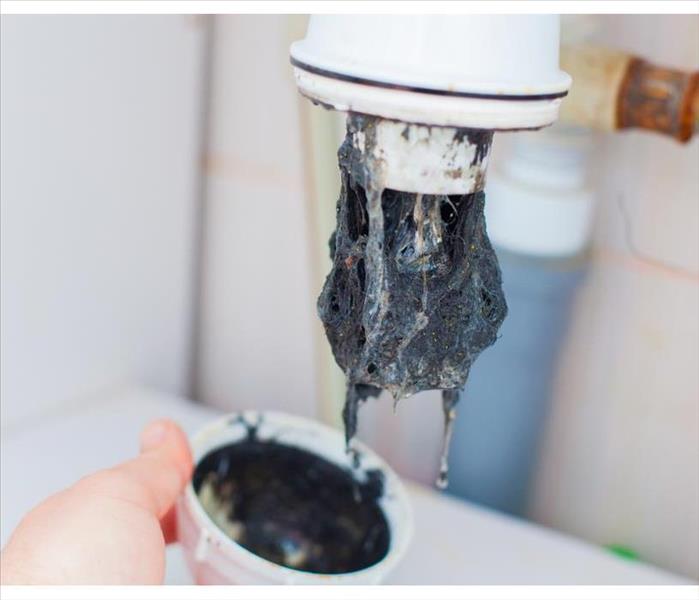 A clogged pipe in your St.Charles,IL bathroom can cause the toilet to overflow
A clogged pipe in your St.Charles,IL bathroom can cause the toilet to overflow
Nobody wants to have to deal with a toilet overflow. Not only can the water that runs over the top of a toilet be disgusting to clean up, but it can also destroy tile, wood floors and bathroom fixtures. Most overflows occur immediately after flushing the toilet. These are usually the result of a clog in the toilet itself. If your toilet overflows when you are showering, however, the problem may be deeper inside your overall plumbing system. Before schedule sewage cleaning, you should know a few things about the workings of your toilet and your shower.
A Deep-Down Clog
When a toilet overflows while you are in the shower, the culprit is usually a clogged pipe between the toilet and the sewer system. When your shower drains, wastewater is unable to makes it way past the clog. Instead, it eventually backs up into the toilet, causing an overflow. Deep-down clogs may be due to a variety of factors, including:
- Wash cloths, rings and other artificial debris
- Hair
- Tree roots
- Disintegrating or collapsed pipes
A Clog-Removal Strategy
Removing the sort of clogs that cause water backups is often a do-it-yourself project. It is sometimes possible to push clogs through with a plunger. If that doesn’t work, you may need to add a snake to your sewage cleaning strategy. You can likely use the snake to reach the clog either through the toilet or the drain clean out. If the snake doesn’t do the trick, you may need to call in a plumber.
A Way To Address Black Water
You don’t have to deal with an overflowing toilet in your St. Charles,IL, home. Instead, understand the cause of your overflowing toilet and work to remove drain clogs. Remember, though, black water usually contains untreated sewage that can be hazardous. If your toilet overflows, hiring a professional restoration specialist is usually your best bet. These experts have the knowledge, skill and equipment to effectively deal with contaminated bathroom surfaces.
Black Water Facts
9/21/2018 (Permalink)
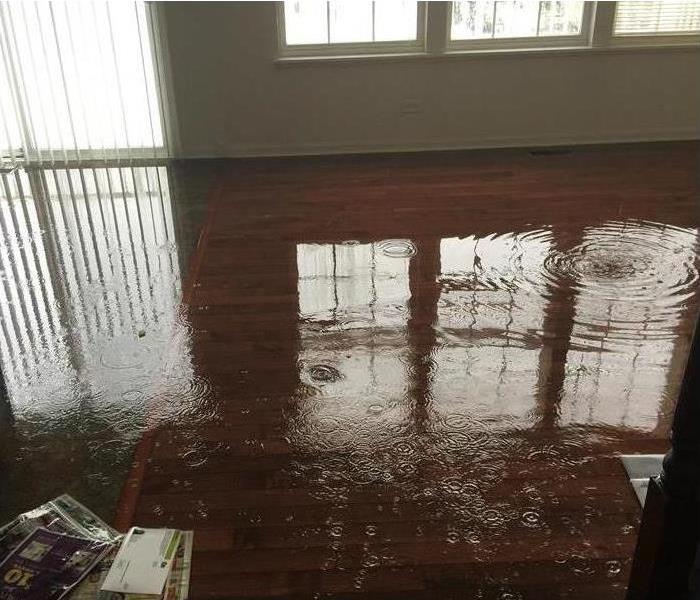 Floodwater damage in a Geneva, IL home
Floodwater damage in a Geneva, IL home
To folks who own homes in Geneva,IL , the prospect of floodwater damage in the aftermath of water infiltration can be a chilling thought. The type of inundation makes a difference in what will likely be required for effective remediation, and some floods are definitely worse than others.
Defining Characteristics
Black water is the term used to describe a type of liquid that presents a risk to the health of humans and animals upon exposure. Sources of this unsanitary condition include the following:
- Sewage from a toilet or bidet containing urine and fecal matter
- Flood water from rivers and streams
- Ground surface water entering a home or building
Aside from the expense and inconvenience of water damage, serious illness and disease can result from encountering unsanitary water in various ways. Ingesting it, inhaling it in droplet form, and even exposing broken or unbroken skin can be hazardous to one’s health. Campylobacteriosis, cryptosporidiosis, giardiasis, leptospirosis and gastroenteritis are common infections caused by this kind of exposure and typically produce diarrhea, fever and chills. More serious threats include hepatitis and infected wounds that can escalate to become life-threatening, especially if left untreated.
Remedying Concerns
A timely and professional response is crucial in remediating a home compromised by raw sewage. Contaminated water must be extracted, and an assessment of what can withstand antimicrobial cleaning, and what must be discarded, must be made. Because mold can begin growing within hours of a deluge, thorough drying of the area is likely to be one of the first steps to take.
Water damage of any kind is an event that no homeowner relishes, but the presence of biohazards can add anxiety to an already challenging situation. Bringing a home back to its pre-flood cleanliness and comfort is doable in most situations. Safe and effective industry-standard procedures have been developed and can take away the worry associated with black water flooding.
Why You Need a Professional Response to Home Flooding
8/15/2018 (Permalink)
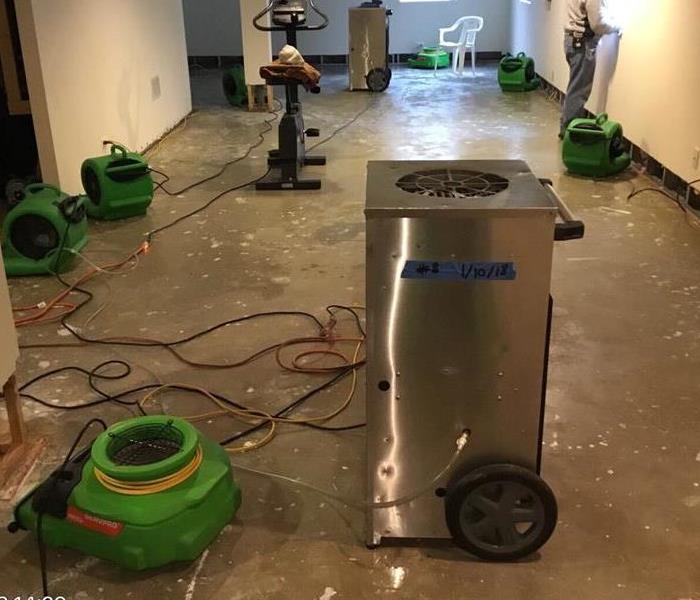 Mitigation procedures after a basement flood
Mitigation procedures after a basement flood
Once your St. Charles, IL, home has been exposed to flood damages, it's important to take steps to avoid secondary damage. This type of damage occurs when the materials of your home suffer because of indirect exposure to water or contamination. Some of the results include the growth of black mold or swelling wood floors. There are several common causes of this type of damage.
• Flooding wasn't cleaned up completely or soon enough.
• Type of dehumidification wasn't adequate for the circumstances.
• Areas of exposure were overlooked during the assessment phase of recovery.
Water Extraction Machines
If your home has been affected by flooding, your wet/dry vacuum, air conditioner, and fans won't have enough impact on the high humidity levels resulting from the presence of so much water. Professional extraction machines quickly remove water without giving it time to evaporate as quickly into the air of your home. The speed of water removal also decreases the chances of excess water getting under the walls and other hidden areas of the home.
Dehumidification Equipment
As water evaporates in the home, it will condense on parts of the home that hadn't initially been affected by the flooding. Porous materials, such as the wall materials, then become ideal for the growth of black mold. Professional-strength high-volume dehumidifiers are necessary to remove as much moisture from the air as possible, as quickly as possible.
Professional-Strength Fans
High-speed fans are also necessary to prevent standing water from seeping into the porous materials of your home and furnishing. Household fans could be used in a pinch, but if you have access to professional-strength fans, they are the best option.
Protect Your Home With Professional Results
As soon as your home has been affected by flooding, protect it, your furnishings, and your family from the effects of secondary damage. Reach out to flood restoration professionals with the equipment and training to prevent black mold, permanently damaged wood, expensive reconstruction, and all of the other damage that could occur. Check with your insurance company concerning flooding policies.
For more on St. Charles click here.
Understanding Category 2 Water Damage
4/24/2018 (Permalink)
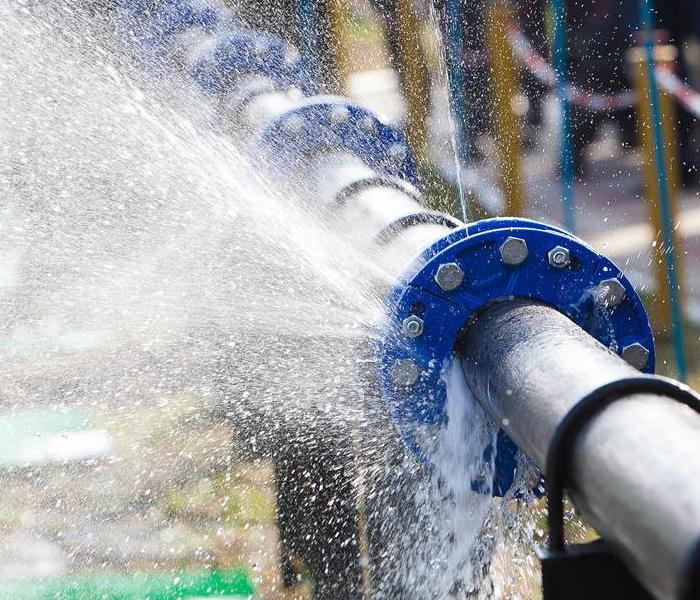 Broken pipes can cause severe damage in your commercial building
Broken pipes can cause severe damage in your commercial building
If you don’t take care of a water pipe repair, you could end up with a flooded business. To make sure your building is restored to its undamaged state as quickly as possible, it’s important to contact a water mitigation expert in Geneva, IL. The first thing an expert will do is assess the flood water to determine whether the water is category 1, 2 or 3.
Flood water is categorized based on how contaminated it is with substances that pose a threat to human and animal health. Category 1 is clean water that’s drinkable at its source – for example, from a broken pipe. Category 3 water is highly contaminated with bacteria, microorganisms and viruses that can cause serious illness. Sewage from a backed-up toilet is category 3 water. So what is category 2? Sometimes called grey water, category 2 refers to water that contains some contaminants that may cause illness if swallowed.
Where Does Category 2 Water Come From?
Category 2 water can be classified as such right from the source, or it can be a result of category 1 water from a broken water pipe repair that has come into contact with contaminating materials. Some potential sources for grey water include the following:
• Overflow from washing machines
• Overflow from dishwashers
• Toilet overflow containing only urine
• Water flushed from sink drains
• Stagnant category 1 water
• Category 1 water that has come in contact with building materials
If you need to do a water pipe repair but put it off and ended up with a flood on the second floor, the water on the second floor would probably be classified as category 1. If that water seeps through the floor and leaks through the ceiling of the floor below, the water on the lower floor will probably be classified as category 2. An experienced water damage mitigation expert in Geneva, IL, can help you deal with both.
Click here for more on Geneva.
Understanding What Happens to Building Materials When They Get Wet
3/16/2018 (Permalink)
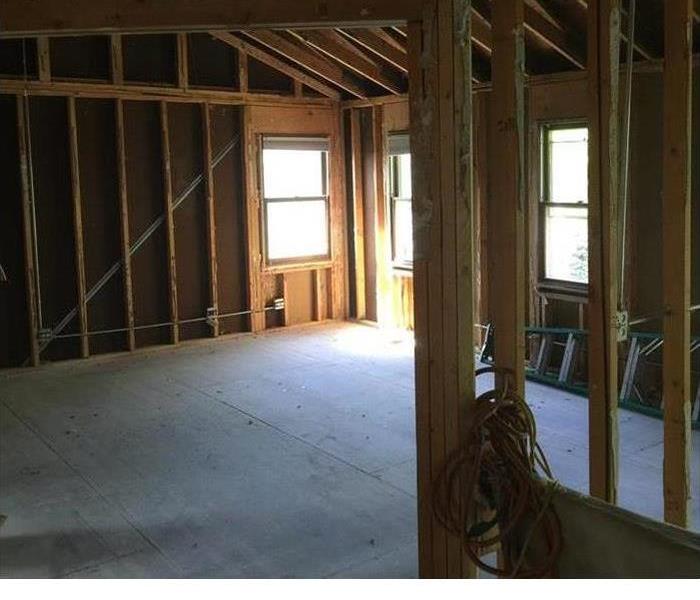 Home suffering from Water Loss
Home suffering from Water Loss
Water damage from any type of water deluge can be devastating to a home’s structure and not just to the contents within it. From swelling wood to supply line damage, the damage that an influx of water has the potential to cause can be costly and extensive. If you want to know what to expect from a burst pipe, flood or any other type of water issue, keep reading. Some common issues that stem result from sitting water include:
• Weak drywall
• Swollen wood
• Ineffective insulation
• Bad electrical
• Contaminated furniture and flooring
Common Structural Issues From Water Damage
Though a burst pipe is unlikely to cause the foundational damage a flood can cause, it can still wreak havoc on your home. If your home has been subject to several water deluges in the past, you may notice a few subtle signs.
For one, your drywall may become weak and begin to crumble, get soft or grow mold. If this happens, your drywall needs to be replaced and the structure of your home dried out, otherwise the swelling wood will continue to swell and cause additional damage. If your walls are plaster, you may be able to get away with simply drying the material.
Another sign you may notice is that your home doesn’t retain heat or cool air as well as it once did. Water damaged insulation is no longer effective and should be replaced when the drywall is replaced.
Depending on how extensive the damage was, you may notice that some outlets or switches don’t work as well. If there are electrical lines behind the damaged areas of drywall, the water surge may be the cause.
Finally, you may notice that your furniture and flooring take on a musty, moldy smell. If this happens, chances are because your furniture and carpet are contaminated, in which case, you would be better off replacing those items.
From swelling wood to bad electrical, a burst pipe can wreak havoc. If you’ve recently experienced a water surge, contact your St. Charles, IL, water restoration team for immediate and effective water pipe repair and restoration efforts.
Visit us at http://www.SERVPROstcharlesgenevabatavia.com for more information.
How to Keep Pipes Safe During a Freeze
1/31/2018 (Permalink)
Winter can be a beautiful and festive time of year. However, if you don’t adequately prepare your home, the freezing temperatures of winter can cause frozen pipes that burst and flood your house. If that happens, you could end up needing professional restoration services and water line repair. Here are some of the most vulnerable pipes:
• Outdoor pipes for pools and sprinklers
• Units in basements
• Pipes in attics and garages
• Units under kitchen and bathroom cabinets
Avoid frozen pipes in these areas with a few steps.
Drain Outdoor Lines
If you have a swimming pool or a sprinkler system, follow the manufacturer’s directions for draining the supply lines before a freeze comes to St. Charles, IL. You may be tempted to use antifreeze in these outdoor areas, but such chemicals can be harmful to the environment, your yard, your animals, and children.
Insulate Indoor Areas
Pipes in basements, attics, garages, and crawl spaces freeze because these areas aren’t always well insulated. While the rest of your house may be comfortable when the weather is cold, these areas can see below freezing temperatures. Adding insulation in these parts of your home can keep the temperatures safer for pipes.
Protect Cabinets
The pipes in your kitchen and bathroom cabinets can get too cold because your heater doesn’t affect the air around them. You can use heat tape or a similar product to keep these pipes safe from freezing temperatures. You may also consider a pipe sleeve. If a sudden freeze is coming and you don’t have these products, you can wrap the pipes in a newspaper and keep the cabinets open.
If you do end up with frozen pipes that burst, be sure to turn off the water supply to the pipe and secure the area. Then, you can call a professional restoration company to fix the damage. Doing so can help keep mold and other damage at bay. Visit http://www.SERVPROstcharlesgenevabatavia.com for more information on water damage.
The Repair Of Water Damage
9/27/2017 (Permalink)
The Repair Of Water Damage
Homeowners or business owners that experienced water damage need to act quickly to begin the restoration process. These are the steps that the restoration company will follow during the restoration process of a flooded home or business:
1. Prevention Of Additional Water Damage:
If the water in home is coming from outdoors, the restoration company will block the areas it appears to be coming in from. If a pipe break occurred, measures will be taken to prevent the pipe break from leaking while it's being repaired. If a main pipe break occurred, the water to the house may have to be shut off. If it's a supply line break, the restoration company might close a valve to prevent water from reaching the supply line break. Then, the restoration company will repair the pipe break in a way that ensures the leak won't recur.
2. Water Damage Assessment:
If there is any uncertainty about what caused the water damage, this will be determined before the water cleanup begins. If the cause is known to be a weather event, professionals will still have to carefully evaluate exactly how the flood damage happened. If a supply line break occurred, restoration professionals will determine if the supply line break was caused by any specific factors.
Then, the severity of the flood damage will be determined. The severity of flood damage on surfaces is measured using a hydrometer. Since flood damage often causes mold growth, restoration professionals will check areas of a flooded home that are likely to harbor mold. Infrared cameras are used to determine if there is water in home behind walls.
3. Removal Of Water In Home Or Water In Business:
Water in home or water in business is removed using powerful pumps that are designed specifically for water cleanup. If you have a severely flooded home, submersible pumps are utilized. In more minor cases, water in home or water in business can be removed with a wet dry vacuum.
4. The Drying Process:
Surfaces of a flooded home or business can remain wet for a long period of time after the water is pumped out. In order to expedite the drying process, water cleanup professionals pay close attention to the air in the building. Water cleanup professionals use dehumidifiers and air movers to create ideal air conditions for drying. Air movers are devices that are specially designed for drying and create an air current.
5. Ensuring The Building Is Sanitary:
The mitigation of mold growth will begin as soon as the water is removed. Specialized equipment and cleaners are used for the mitigation of mold. If mold growth has begun, the removal of some items may be necessary. This could even include materials that are located above the water line.
Porous surfaces with mold growth are often removed, but non-porous surfaces are typically cleaned during the mold mitigation process. Appliances that have been waterlogged often have to be disposed of. It is difficult to assess whether or not they have been affected by mold damage. In many cases, the filters of the heating system will need to be replaced.
Personal belongings also will be cleaned. There are various methods that can be utilized to clean personal items. However, some personal items may have to be disposed of. This is especially likely for items that have become moldy.
Professionals will also deodorize the building using specialized sprays and scented cleaners. This process is likely to be especially extensive if you had water in business due to the fact that the odor created by wet materials can deter customers.
6. Replacement:
Items that were removed during the mitigation of water damage can be replaced by the restoration company.
Visit http://www.SERVPROstcharlesgenevabatavia.com for more information on water damage.
Water Damage: What Needs to Be Done
8/31/2017 (Permalink)
Water Damage: What Needs to Be Done
Water damage is no laughing matter. Whether a person experiences water in a home or water in a business, the focus should be on water cleanup as a way of minimizing the damage. Calling a restoration company is critical to help with mitigation and restoration. It's important to understand what they will do in order to make a difference.
Minimize the Problem
If there is a pipe break or a supply line break, it can result in hundreds if not thousands of gallons of water. Any amount of water in a home or water in a business can be detrimental. Mitigation becomes the biggest focus as it's necessary to minimize the problem.
While some mitigation can be done by the home or business owner, it's important to call in a restoration company. It's what will make it easier to focus on water cleanup, drying, and getting the water in a home or water in a business out.
Additionally, the pipe break or supply line break needs to be addressed so that the influx of water can stop. If it's a flooded home because of the weather, then it might be necessary to bring in sand bags and try to divert the water until the storm passes.
Any level of mitigation can be helpful. By working with professionals, it's a lot easier to prevent water damage and focus on any flood damage that has occurred.
Start Drying the Affected Areas
Water damage can begin almost immediately. Some materials are more apt to be affected by a flooded home than others, which is why mitigation is of the utmost importance. Many people don't realize how much water can enter a home or business as a result of a pipe break or supply line break until it happens.
Drying will help with the water cleanup. All excess water needs to be removed. By working with a professional restoration company, they will be able to use state-of-the-art equipment to help with drying. The walls, floors, furniture, and more can be dried effectively to minimize the water in a home or water in a business.
When it comes to flood damage, it's important to identify what can be repaired and what needs to be replaced. Items inside of a flooded home that are too wet and cannot be dried need to be discarded. Additionally, if the water is from a supply line break or pipe break that does not have potable water, such as sewer water, part of the water cleanup will also involve sanitation.
Address the Issues
All sorts of issues will need to be addressed when there is a flooded home or business. No one wants to get rid of more than what's necessary. Additionally, the flood damage has to be corrected so that a person can move back into their home or re-open their business.
All water damage has to be identified. From there, it will be easier to see what needs to be tossed and what can be salvaged. A restoration company will be able to ensure that the water doesn't cause long-term damage, such as mold or wood rot, too.
Create a Restoration Plan
A restoration plan needs to be put into place to deal with the flood damage in a home or business. Professionals will now how to make a plan and coordinate with insurance if necessary.
No one should try and handle the water damage to their property alone. With the help of a good company that knows about restoration, it will be easier to figure out what needs to be done the moment there is too much water inside of a building.
Visit http://www.SERVPROstcharlesgenevabatavia.com for more information on water damage.
Preparing for Water Damage
6/21/2017 (Permalink)
Preparing for Water Damage
Water is essential to the life of a human being and a lot of it can cause a lot of destruction. Thus it is inevitable and when it happens then one must carry out water damage restoration.
What is water damage?
This is the destruction that is caused by excess water during a given period of time by water in home or water in business. When there is excess water in home or water in business certain materials are bound to get spoiled. This includes materials such as ceiling board, wood, and steel among many others. Water in home and water in business precipitates certain processes such as the rotting of wood and rusting of steel. The damage caused by water in home or water in business may happen gradually especially when there is damage to your drainage system and plumbing system or all over sudden during natural catastrophes such as floods or hurricanes.
The process of water damage
There are various categories which can exist in any premises. They include:
• Category 1: This is basically called clean water. It is mostly caused by damage to the water supply system, when a sink overflows or when there is a problem in the clean water system of the home. This can cause damage in the home or even in the office.
• Category 2: This is also called grey water. This type of damage has a large number of contaminants caused by physical, chemicals or biological pollution. It causes damage in the home or in the office after plumbing system problem, water from washing machines or even a dishwasher.
• Category 3: This called black water. This is the worst form of damage. It contains dangerous contaminants like sewage water.
In addition to this, it can also be classified as class 1 which has a sluggish pace of evaporation, class 2 with a quick pace of evaporation, class 3 with a quicker pace of evaporation and class 4 with the quickest pace of evaporation.
What to do if you have water damage.
The damage is sometimes attributed to natural causes, therefore it is deemed to be inevitable. In the event that it occurs, the first step that one should think about is how water drying will be done. The water cleanup requires water restoration methods which will lead to complete drying of the premises. The water restoration techniques used are determined by the period it has been stagnant and the amount of damage that was caused. Depending on the destruction caused the water restoration may be carried out by a professional or even by the premise owner. Hydraulic restoration is basically drying of the water which should be done as soon as possible to reduce further damage. During the water cleanup, extensive labor may be used especially if the damage is significant. Professional water cleanup requires proficient equipment.
Immediately there is damage to any premises, all electrical appliances should be disconnected. All water sources should also be closed or stopped especially if the water is from a leaking tap, water line or any kind of seepage. Mitigation should be carried out by a professional. During the mitigation, equipment used to detect water will be used to establish the extent of the destruction. Floating materials should be picked and kept safely. The water cleanup exercise should be done efficiently by qualified personnel especially if the damage is extensive. Hydraulic damage should be eliminated by drying the premises completely.
How to recover your home after flood damage:
Flood damage is one of the hydraulic damages that cannot be prevented. In the case of flood damage, all electric appliances and gas should be promptly switched off. One should ensure that they are properly insulated while doing this. Before proper mitigation, one should assess the general damage before the water cleanup is carried out. Photos of the flood damage area should be taken for further assessment. Water cleanup involves picking up of important materials around the house before the drying begins. One should contact professionals for the mitigation process to begin.
Visit http://www.SERVPROstcharlesgenevabatavia.com for more information on water damage.
Key Tips When Dealing With Water Damage In Your Home
6/2/2017 (Permalink)
Key Tips When Dealing With Water Damage In Your Home
Floods can destroy your home and cause significant damage to the floors, walls, furniture, and electronics. The solution is to rip out the damaged walls, tear out the carpets, and find the hidden pools of water in home crawlspaces. When water gets in business floors and working areas, you will have to close for a few days.
Flood protection initiatives
By redirecting the floodwaters, you can reduce the amount of water in business parking lots, entrances, and working areas. You can rely on the following flood mitigation tips if you are looking to protect your home from water damage and lower the cost of restoration:
• Understand your neighborhood and ask the relevant authorities about the flood risks in the area.
• Elevate your water heater, furnace, and other electrical appliances above the expected flood levels.
• Inspect your drains and sump pumps regularly.
• Modify your home’s electrical system to ensure that you can connect a backup generator in case you need power to remove the foul water from the house.
• Ask a licensed plumber to install a backflow prevention valve in the sewer
• Use sandbags to divert the water away from the foundation.
• Acquaint yourself with the flood alerts in your neighborhood to avoid surprises
• Store some building materials in your home since you might be unable to take them to the building site when it floods
• Design a safe evacuation route that you can use to safeguard your family from the floods
• Train the family members on how to shut the power mains and utilities
• Purchase a survival kit and pack your important documents, medications, and critical items that you require in case you need to vacate your home
• Flooding can cause the entry of excess water in home compounds and pose a variety of risks to the occupants
• Get the latest information from the media and respond to the news immediately
• Avoid walking or driving in the muddy areas and move to a high ground. Floodwaters carry lots of hidden items that might pose a lot of risks
• Avoid the fallen power lines and cables as you perform the restoration and water cleanup exercises
Water cleanup and drying the indoor air can help to prevent the flood damage.
Water Cleanup
Once the floods subside, you can return home to start the repairs. Start by discarding the food items that have expired or come into contact with the foul water. Remove the water as soon as possible and assess the building with the help of a home inspector. Remove the water from your basement and pump it out slowly to avoid the uneven pressure that can lead to structural damages. In addition, such water in home surfaces can lead to the propagation of molds. The best way to tackle the problem of water in business entrances is to erect some permanent barriers to control the floods. The water cleanup might also involve washing and disinfecting all the flooded areas. These areas include floors, carpets, and walls. When dealing with the flood damage, tart drying the carpets if you think that you can salvage them. When dealing with the water in business setups, discard anything that cannot be salvaged and plan to replace it after restoration. Inspect your heating and air conditioning system and look for any signs of flood damage.
Safety precautions
However, you should not test any electrical appliances without the assistance of a competent electrician. The prospect of finding the water in home carpets and other items can cause disappointments, and in most cases, you might not know where to start. When planning the mitigation and removal of water in business premises, you must get reliable information about the water damage and flood levels in the area. Elevating your home is one of the best mitigation initiatives to prevent water damage and avoid the costly restoration jobs. Drying the home after flood damage can help you to implement your mitigation plans successfully. You can also reduce the water damage by drying the indoor air.
Visit http://www.SERVPROstcharlesgenevabatavia.com for more information on water damage.
Facts About Water Damage Restoration
4/28/2017 (Permalink)
Facts About Water Damage Restoration
Water damage can arise either internally or externally. Externally as a result of floods surging in your house or internally as a result of a fault in plumbing, be it leaky roofs, broken pipes, blocked toilets and sewer line or leaking taps. Therefore, you cannot just assume that you will not be faced by water damage if you don’t live in a flood-vulnerable area. The little plumbing issues we see and neglect, every day, could be the cause of damage from water in business and water in home. The following tips will help you in water in flood damage and water damage restoration.
Mitigation of Water Flow
It is not in all cases where you will be able to stop the flow. In the case of surging flood, you might have to wait until the river recedes. However, if you are dealing with small leaks or other minor plumbing issues, there is something you can do about the flow. You can turn off water from the mainline. But, if you cannot find the water mainline, you can repair the leak yourself. This will help in the mitigation of further water damage before the water damage restoration experts get to your property.
Take Care of Wet Items
Anything that has been affected by the water damage should be taken out, where there is more air movement, for drying. Check for any fabric that could be handing in the pool of water, from curtains to furniture skirts. You will need to wash these before exposing them to high air movement, for drying Also, remove anything that you think might transfer ink or stain on your carpet. Drying items in a place with high air movement is a great step towards the mitigation of more loss.
Caring for Dry Items
Take aluminum foil and place it on the legs of your furniture. This will prevent them from getting in contact with water in business or water in home. Therefore, preventing permanent staining on your furniture. And, if you have items that are portable, you can move them to a higher ground to prevent water from reaching them. This will help in the mitigation of further secondary loss from flood damage.
Electricity Handling
If you have electronics that have been damaged by water in business or water in home, you need to have them unplugged. But first you need to shut off the electrical breakers in the area affected by flood damage. Next, ensure that you are standing on dry ground. However, you should avoid placing newspaper as a stepping ground. His is because, it might stain your carpet.
Water Cleanup
The water cleanup process can be a DIY job or you can call a water cleanup expert to do the job. Drying is a very important step in water damage restoration. And hiring a water cleanup pro is the best way to go. They will assess the air movement to ensure that you are free from moisture.
Call Your Insurance Company
In case of a water loss, be it because of water in business or water in home, it is important that you call your insurance company as soon as possible. If the water loss is due to floods, then you must have a separate insurance against flood damage. Ensure that you have photos and videos evidencing the damage. Visit http://www.SERVPROstcharlesgenevabatavia.com for more information on water damage.
Steps to Take After Water Damage
3/30/2017 (Permalink)
Steps to Take After Water Damage
No matter where in St. Charles or Batavia, IL or anywhere
else in Illinois you live or do business, water damage can happen at any
time without warning. Whether it is caused by torrential rains,
floods, leaky or busted pipes, or plumbing issues, it is important to
take action as quickly as possible to protect your property. All it
takes is an inch of water to cause serious damage to your furnishing,
structure and even the foundation of a building. The faster you get rid
of the water and begin the drying out process, the sooner you and your
loved ones will be able to safely return to your home or business and
your normal life.
The actions you take immediately following a water loss are crucial.
They can help to protect the lives and health of everyone in the
structure and limit the damage. The first thing you should do is
determine the source of the water. If it is from a flood or heavy
rains, then you should get to a safe location. If the excessive water
in home or water in business is caused by a problem with the plumbing,
you should turn off the water main if you can do so safely. This is the
wisest course of action because it will stop the flow of water and
limit the damage to your property.
Another important step you should take if your home or business is
inundated with water is turn of the electricity and unplug your
electrical appliances. Water and electricity is a dangerous mix. If
you can safely get to the main power switch without endangering yourself
or others, make sure your hand are dry and you are not in standing
water and turn the power off. If attempting to do so will endanger you
or others, simply leave the building and contact the power company and a
plumber. They will know what to do to get the situation under control
and protect the property and the people in it.
One you have ascertained that no one is injured, your next call should
be to your insurance company. Let them know about the water loss that
happened and the actions you've taken. An insurance adjuster will come
to your St. Charles or Batavia, IL home or business and assess the
situation. At that point they will see the damage the water in home or
water in business has caused. They will discuss your mitigation options
with you and help your to find a water cleanup company to get the water
out of your home or business. There are quite a few water cleanup
companies serving Illinois. So it's important to understand what you
need and do some research until you find the right one.
Although your insurance company may be able to suggest a number of water
mitigation companies you can use, you should feel free to do some
research on your own. The companies can vary widely when it comes to
pricing and the types services they offer. Therefore you should contact
the local branch of the Better Business Bureau. They will be able to
give you a list of highly-rated companies with experience cleaning up
properties that have been damaged by water. Whether you suffered flood
damage, broken pipes or any other type of water inundation issues, there
are a number of excellent companies from which to choose.
One of the most important steps in the process of helping your property
to recover from the damage caused by large amounts of water is to begin
the drying process. The need for air movement through the property is
crucial. If an adequate amount of air does not pass through your home
or business during the cleaning process, mold and other types of fungus
may begin to grow. That can make the air quality in the structure
dangerous and cause the people that frequent the building develop a wide
range of illnesses. The mold and mildew growing in the damp places in
your home or business can even cause infants, the elderly and others
with weakened immune systems to become seriously ill or die.
Some people try to save money by cleaning up the damage caused by the
water inundation themselves. But this can be a major mistake.
Professional cleaning companies have specialized tools and employees
that are trained to safely remove the water and repair the damage it
caused. They also have experience identifying the places in the
structure where moisture can hide. Plus the professionals know how to
quickly and safely remove unsanitary carpets and furnishings. Often
people trying to do the cleanup themselves don't have the appropriate
safety gear to protect their health during the cleanup process and can
become ill. The professionals also have the skills and equipment to
create air movement and handle unforeseen problems that may arise.
Water loss is the most common type of insurance loss claim. Whether the
problem is caused by frozen or broken pipes, sewage backups, leaks from
appliances or floods, the damage and losses are generally covered under
standard property insurance policies. But filing the claims can be
challenging. Therefore it's essential to properly document all the work
that's done to repair the damage done by the water event. This
includes keeping receipts from hotels if you're forced to spend a night
or two away from your home or the cost of replacing products lost in
unplugged refrigerators. This will help you to get fair compensation for
your losses and expenses.
How water damage or flood damage is addressed within 24 hours after it
occurs is critical. It can make at dramatic difference in the impact it
has on your property. Getting a cleanup team working on the problem
right away can prevent mold from developing and the deterioration of
sheetrock, flooring boards and even serious damage to the foundation.
So don't hesitate when it comes to getting a skilled team to come in and
address the damage caused by the water event.
Visit http://www.SERVPROstcharlesgenevabatavia.com for more information on water loss and the restoration process.
How to Thaw Frozen Pipes and Avoid Flood Damage
2/24/2017 (Permalink)
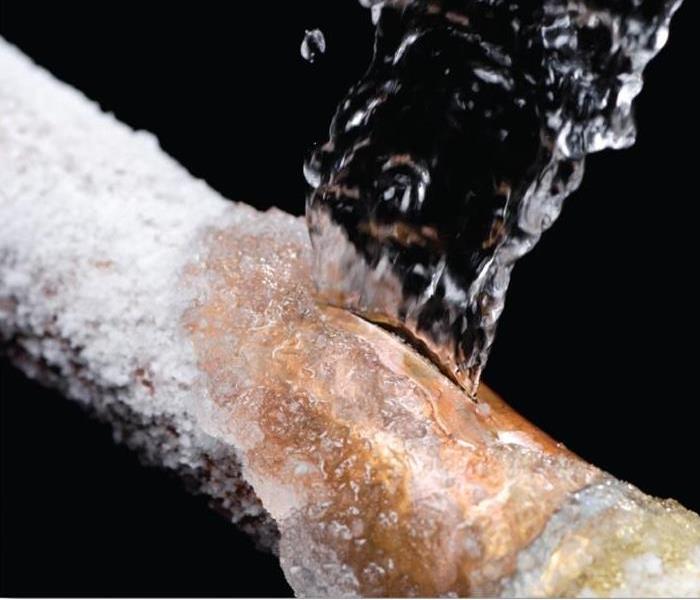 Frozen Pipe
Frozen Pipe
Although it’s been a mild winter, the Tri-City area of St. Charles, Geneva, and Batavia is no stranger to freezing temperatures and the troubles that come with it --like flood damage from burst frozen pipes. Unfortunately, flooding due to frozen pipes is usually a significant portion of our emergency flood damage restoration services calls this time of year. And while we readily answer these calls for help, we would much rather aid you in trying to prevent such a disastrous event by showing you how to thaw frozen pipes gently.
However, the first part of avoiding a burst pipe is understanding why frozen pipes burst and cause water damage.
Why Frozen Pipes Burst
Frozen water expands, and although the expansion can be as little as 9 percent in volume, the pressure from this slight expansion is great. When measuring pounds per square inch (psi), the pressure inside your pipes can go from the normal 40 psi to 40,000! It's not hard to imagine why a pipe, even strong copper piping, would burst under these conditions.
Because pipes are under such extreme pressure, you must take extra precautions when attempting to thaw frozen pipes.
While many St. Charles residents successfully thaw frozen pipes on their own, we want to stress the importance of personal safety. Use your best judgment when it comes to doing DIY home repairs. Call a plumber when in doubt and call SERVPRO of St. Charles/Geneva/Batavia for flood damage restoration.
Tell-Tale Signs of Frozen Pipes
- Exposed piping may have ice or frost surrounding it as the water on the inside begins to freeze.
- Reduced or no water flow from faucets. We recommend keeping one faucet to a slow stream. Flowing water does not readily freeze and any signs of diminished flow will serve as an immediate warning that your pipes are freezing.
Thawing Frozen Pipes
If you see any of the above signs, immediately turn up your home's thermostat. Open all the vents and doors to allow warm air to flow throughout your home.
Don't forget to open the cabinet doors under sinks! Pipes that are not covered by insulation are susceptible to freezing. Opening lower cabinet doors so that the warm air can reach those areas.
If you suspect a pipe is frozen because you see ice forming around it, you can attempt to heat the pipes directly. There are several ways to do this. However, SERVPRO of St. Charles/Geneva/Batavia recommends these most frequently used methods:
- Using a hair dryer to blow warm air onto the pipe
- Soaking towels in warm water and wrapping it around the frozen pipe
- Placing a space heater in the room where the pipe has frozen. Never leave a space heater unattended
Also, ever use a direct flame on your pipes, such as those from a candle or blowtorch.
As silly as it may sound, knowing how to thaw frozen pipes is a necessary life skill for us in St. Charles, Geneva, and Batavia. Icy weather in our community is not a "maybe" but a "when."
Save this blog post for future reference when your pipes freeze and keep our number in your cell when you emergency storm damage restoration.
Leaky Air Conditioners
7/8/2016 (Permalink)
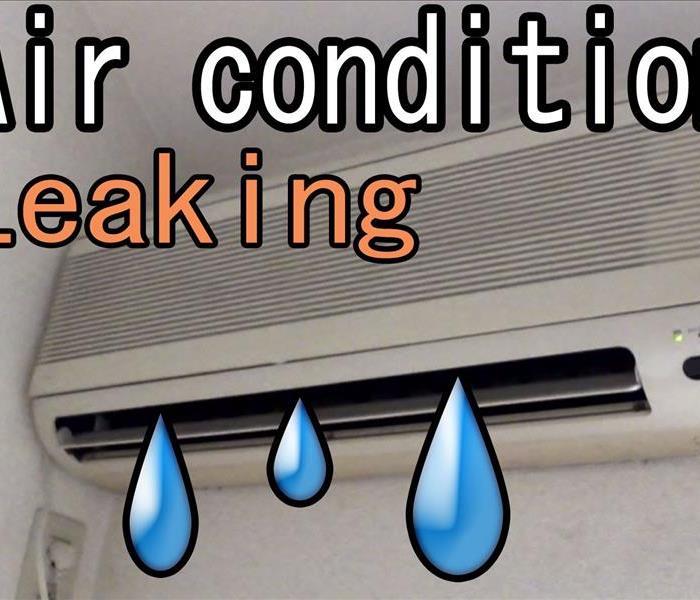 air conditioner
air conditioner
Batavia Home Care: Preventing Water Damage From Leaky Air Conditioners
Leaking air conditioners can cause water damage and mold growth if it’s not corrected early. The best way to prevent water damage from air is to do regular check-ups of the system. From visual inspections to simple maintenance, Bavatia water damage from leaking attic or rooftop installed a/c units can be avoided with these easy-care tips:
1. Inspect the Overflow Pan
Located under the main a/c unit, the overflow pan catches any condensation that is not being drained out the condensate drain line. You’ll want to inspect this pan for any holes and cracks. If the overflow pan has any cracks, you can try to repair it with epoxy or simply replace the overflow pan. Finding water in the pan is normal, however, it can also be a sign of a clogged condensate drain line.
2. Clean the Condensate Drain Line
This pipe can get clogged with anything from insects to mold, but most often from algae that naturally accumulates from use. An easy way to keep it clear is to pour a small amount of household bleach every 4-6 months to inhibit algae growth. Using a funnel, slowly pour about a cup of bleach down the condensate drain line. If the bleach is not going down the pipe easily, this could be a sign of an already clogged pipe. You can try to suck out the clog with a wet/dry vac, or call a professional to do a thorough inspection of the condensate drain line for you.
3. Inspect the Air Filter
Dirty air filters can block airflow over the evaporator coil. This blockage creates ice to form on the coil, that will eventually thaw and drip when the a/c is not in use. Small drips like this can be overlooked if regular inspections are not made. A slow drip is a silent disaster in the making as it slowly soaks the insulation, wooden beams, and drywall. Mold growth is sure to follow, further weakening a damaging your home.
Regular check-ups of your a/c unit can help prevent and catch leaks before they become a big problem, but some leaks may be missed. Be sure to check for signs of water damage and mold growth around your air conditioning system such as:
• Blistering paint
• Discoloration on the walls or ceiling
• Drips or condensation on the walls or ceiling
• Mildew odor
• Sagging ceiling
• Walls spongy to the touch
If you are in need of water damage restoration or would like moisture levels in your home checked, SERVPRO of Batavia is ready to help 24 hours a day, 7 days a week.
Advanced Flood Restoration
7/8/2016 (Permalink)
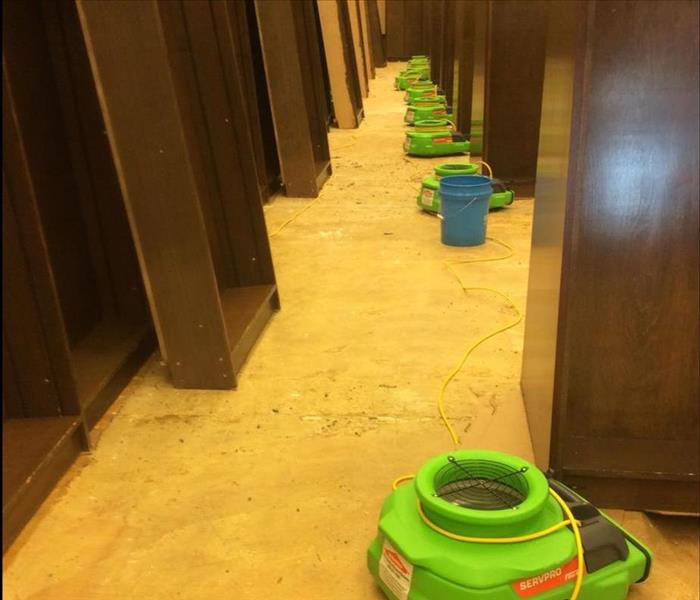 air movers in Barnes and Noble
air movers in Barnes and Noble
St. Charles Home Care: Advanced Flood Restoration Services
Flood restoration may seem as simple as extracting standing water and drying waterlogged items; however, there’s a lot more to it than meets the eye. Specialized equipment in the hands of trained technicians can make a disastrous event, like extensive St. Charles flood damage, seem like it never happened. Advanced flood restoration services can:
• Detect potential problems before they arise
• Reveal damage that is invisible to the naked eye
• Help the technician do the restorative job more thoroughly and quickly
All of which help you get back to your home faster --without the worry that improper flood restoration will be a problem in the future.
Like it Never Happened
Not only is St. Charles SERVPRO faster to any size disaster, but we do such a thorough job in restoring your home that it’ll be like it never happened. We do this by hiring the best service-oriented staff and training them in the trusted SERVPRO-standard for water damage mitigation and restoration.
Moisture Detection
Water damage can occur from both direct water exposure and humidity. St. Charles SERVPRO use meters and sensors to detect moisture levels in carpeting, fabrics, and even wood to ensure that they are at healthy levels.
Measuring moisture and temperature levels with a thermohygrometer aid the technician in getting precise readings in humidity, dew point, and vapor pressure. These advanced moisture detection techniques can reveal hidden water damage and can lower your overall recovery cost.
Water Extraction
Whether the area space is large or small, with standing water or high humidity, SERVPRO has the right water extractor for the job. Truck-mounted and industrial strength portable extractors remove water from floors, carpeting, and upholstery. Specialized dehumidifiers, called desiccant dehumidifiers, lower moisture levels in the environment. This helps to reduce the damaging effects of high humidity and increases the rate of natural water evaporation.
Disinfecting and Deodorizing
With penetrating atomizers to sanitizes and deliver powerful fungicides, SERVPRO of St. Charles takes preventative steps toward protecting your home from mold infestation – a complication from improper water damage repair. Thermal foggers deodorize the air, ridding any last trace of musty or sewage odors.
With SERVPRO’s water damage repair and restoration service, you can trust that you’re working with the best. Our resources include over 140,000 pieces of specialized equipment, the support of over 1,650 SERVPRO franchises nationwide, and hundreds of hours of advanced training. Give us a call today and let us get the job done right—the first time.
Water Tips
3/8/2016 (Permalink)
St. Charles Home Care: Minimizing the Effects of Water Damage
From cleaning out the gutters to inspecting the roof, keeping your home in good repair is vital in preventing complications from water damage. However, not all disasters can be avoided. Pipes bursting, sump pumps breaking down, sewers backing up, and creeks overflowing after heavy rain are all causes of significant water damage in St. Charles. If your home has been affected by flooding, take heart; there are steps that you can take to minimize the effects of water damage to your home.
Shut Off Water Source
If the flooding is caused by a leaking home appliance or fixture such as a dishwasher or toilet, look for the water shutoff valve that is associated with the water supply for that appliance. If it cannot be located, or it does not stop the water from leaking, it may be necessary to shut off the main water supply for the home.
Check the Sump Pump
If you suspect that the flooding is caused by a faulty sump pump, inspect it carefully. First, make sure that it is plugged in. Also, check the fuse box to see if the circuit breaker has tripped. Next, inspect the drain for blockage or a float that is stuck. If the sump pump is still not in working order after reviewing these common problems, it should be replaced right away.
Call Your Insurance Company
Report your claim as soon as possible. If it is after-hours or if your insurer cannot be reached, it recommended that you contact a home remediation provider to begin the restoration process immediately. St. Charles SERVPRO offers a stress-free claims service that works with your insurance company to mitigate the restoration process.
Protect Your Valuables
If it is safe to do so, move valuable items and furniture to a dry and secure place. Remember that standing water and electrical appliances are extremely dangerous, and you should never attempt to enter an area that is not safe. Brackish water, such as that from overflowing creeks and sewers, can also cause serious health problems. After the flooding has subsided, the effects of water damage continue with mold and mildew. Remember that even those household items that have been damaged by moisture or mold in St Charlescan often still be restored by professionals.
The most vital step in minimizing the effects of water damage to your home is that you seek help from home restoration professionals. St. Charles SERVPRO is known as the restoration experts, and we are available 24 hours a day to aid you in restoring your home and valuables after water damage.
Water Situations
2/4/2016 (Permalink)
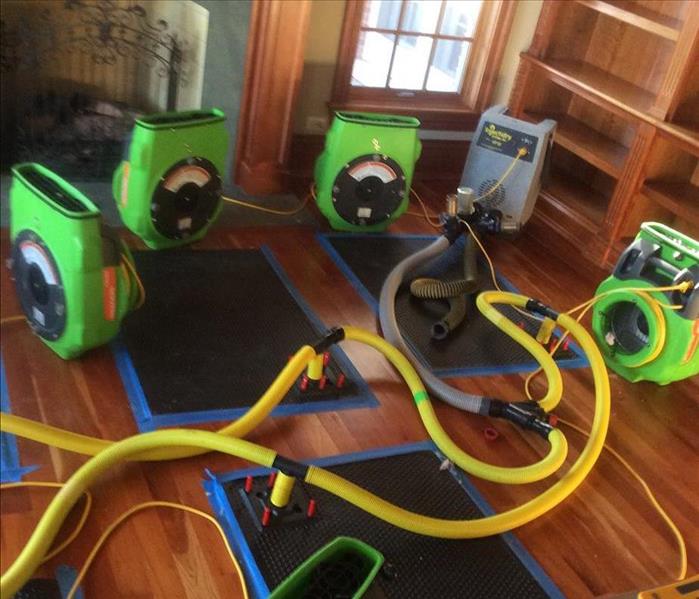 Hardwood floor drying using Injecta Dry equipment
Hardwood floor drying using Injecta Dry equipment
St. Charles Water Damage Remediation Specialists Can Restore Your Property
Broken pipes, backed up sewer systems, failed sump pumps, fires, and Mother Nature can all bring unwanted water into your home. The SERVPRO team of St. Charles, Geneva, and Batavia stand at the ready with the tools and expertise you need when water damages your home or business. We understand the devasting characteristics of these emergencies; remember to protect your health and your property from further harm, the water, debris, bacteria, and residual moisture must be rectified immediately.
We view ourselves as integral community members and in the event of emergencies and water damage in St. Charles, Geneva, and Batavia, you can rest assured we are here to help. After just a short phone call, our team will arrive on site and work quickly to restore your property to its original state while preventing further damage due to the excess water and moisture. When disaster strikes and you experience the devastating effects of St. Charles water damage, call us at (630) 377-7062 immediately. We are available 24x7.
Prevent Structural Damage
Don’t wait to contact us until the next day after experiencing water damage as standing water causes significant structural and mechanical damage to property, virtually immediately. This includes the foundation, support structures, drywall, HVAC, electronic equipment, electrical systems, and plumbing. Additionally, standing water, whether fresh from a flood or black water from the sewer can stain and ruin furniture, clothing, and treasured mementos. The best and often the most cost-effective solution is to call SERPRO for your Batavia water damage needs. Our team will arrive promptly and start to work inventorying items damaged as well as the extent of the structural and mechanical damage, and come up with a plan to restore your property.
Prevent Mold Growth
SERVPRO’s second goal is to prevent mold growth in your water damaged property and in your possessions. Mold is not only unsightly, but it can permanently damage and stain as well as have detrimental effects on your health and your family’s health. With specialized, professional equipment that includes vacuums, pumps, dehumidifiers and high-velocity fans, we can remove all traces of moisture from your home. By acting quickly and eliminating the moist environment that mold and mildew need to thrive, SERVPRO begins the restoration process and can return your home to its pre-damaged state.
The Professionals Of SERVPRO Are Here Help
While it may seem more cost-effective to attempt to do the extensive work on your own, eventually it can be more expensive if the job is not done correctly. Water damage in Geneva can be reversed, but only if you act swiftly and call professional water damage restoration experts that are equipped with the best industry tools, and have the training and expertise you need during this stressful time. All of SERVPRO technicians are IICRC-certified and offer 24/7 emergency services to ensure that your water damage is resolved as quickly as possible.
We provide Water Damage Cleanup and Repair in the following communities:
SERVPRO St.Charles/Geneva/Batavia
11/10/2015 (Permalink)
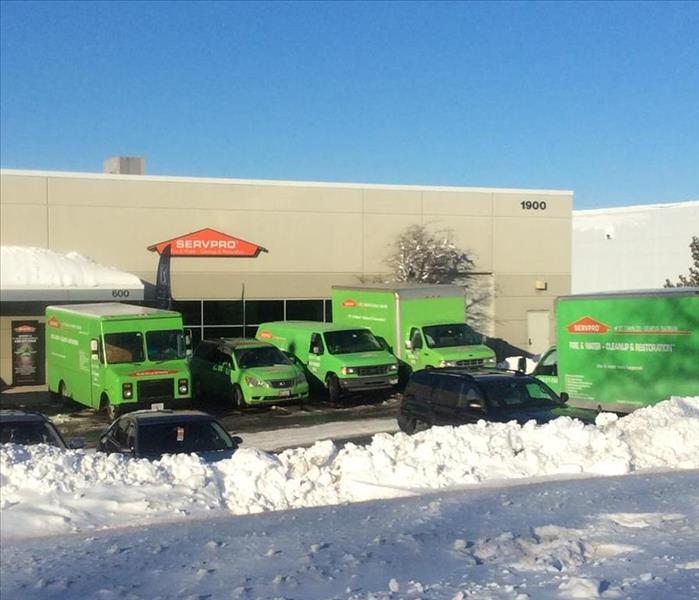 SERVPRO St.Charles/Geneva/Batavia
SERVPRO St.Charles/Geneva/Batavia
St.Charles/Geneva/Batavia Water Damage Removal Tips
10/28/15
A burst hose can fill a house with water.Emergency Water Removal Tips for St.Charles/Geneva/Batavia
Water damage can be quite frustrating in your St.Charles/Geneva/Batavia home. However, you should not panic if your home has suffered water damage. You should start taking the steps that are necessary for eliminating the water. Water can cause serious damage. Removal is of the utmost importance.
There are steps that you can do to address emergency flooding in your home. Below is a list of emergency water removal tips:
Address The Source
Find the source. Once you find the source, it is important to act quickly and remove it to mitigate the water damage. The earlier you do this, the better. Plumbing problems are one of the most common causes of flooding. If there is a burst pipe or other plumbing issue, then the problem will need to be addressed as soon as possible.
Flooding caused by weather requires swift action to attempt prevent the water from entering your home and creating water damage. For example, you can divert the drainage away from your home by using sandbags.
Be Safe
Your personal safety is of paramount importance. You need to take all of the necessary precautions to remove water safely. One of the best things that you can do to keep yourself safe is to turn off the main power source in your home. Water is an excellent conductor of electricity. You will need to keep yourself safe from electric shock while you are trying to remove water from your home.
Keep The Home Aerated
There probably will be a large amount of moisture left inside of your home after you get rid of the water. Moisture can ruin your home. That is why you will need to aerate your home to start to eliminate the moisture. Keeping your windows open will aid in the drying process, if that is possible.
Contact SERVPRO Professional Water Restoration Company.
Your flooding issues may be beyond your control. It is wise to call in the expert professionals to save your home--SERVPRO which is IICRC certified. This company will make sure that the problem will be addressed quickly and in the most convenient way.
Locally Owned Company with National Resources
SERVPRO of St.Charles/Geneva/Batavia is locally owned and operated—so we are part of this community too. We are also part of a national network of over 1,650 SERVPRO Franchises and special Disaster Recovery Teams strategically located throughout the country to respond to large scale disasters.
We are here in St.Charles/Geneva/Batavia and are ready to help you. Just call us. (630) 377-7062





 24/7 Emergency Service
24/7 Emergency Service
